CIRCULAR FLOW OF INCOME - GENERAL
Circular Flow of Income
INTRODUCTION
The term macro is derived from the Greek word ‘makro’, which means “large”. It is a branch of economics concerned with the description and explanation of economic processes involving aggregates.
- An aggregate is a collection of economic subjects that have some characteristics in common.
- Macroeconomics emerged after the publication of John Maynard Keynes' book, ‘The Theory of Employment, Interest, and Money’ in 1936. This branch investigates the economic relationships or issues that affect an economy as a whole, such as saving and total consumption.
- Macroeconomics is the part of economic theory that studies the economy as a whole, such as national income, aggregate employment, general price level, aggregate consumption, aggregate investment, etc. Its main instruments are aggregate demand and aggregate supply. It is also called the ‘Income Theory’ or ‘Employment Theory’
- Macroeconomics is concerned with economic problems at the level of an economy as a whole. Structure of Macroeconomics implies study of different sectors of the economy.
- Producer sector engaged in the production of goods and services.
- Household sector engaged in the consumption of goods and services.
- Note: Households are taken as the owners of factors of production.
- The government sector engaged in activities like taxation and subsidies
- Rest of the world sector engaged in exports and imports.
- Financial sector (or financial system) engaged in the activity of borrowing and lending.
CIRCULAR FLOW OF INCOME
It refers to the cycle of generation of income in the production process, its distribution between the factor of production namely Land, Labour, Capital and Enterprise and finally, its circulation from households to firms in the form of consumption expenditure on goods and services produced by them.
Phase in Circular Flow of Income
- Generation Phase: In this phase, the firm produces goods & services using factors of production (Land, Labour, capital and Enterprise).
- Distribution Phase: In the Second Phase, the firms make factor payments (Rent, wages, Interest & Profit) to the household for providing factor services.
- Disposition Phase: In this phase, the households spend the amount/income received by factors of production in purchasing good and services produced by firms.
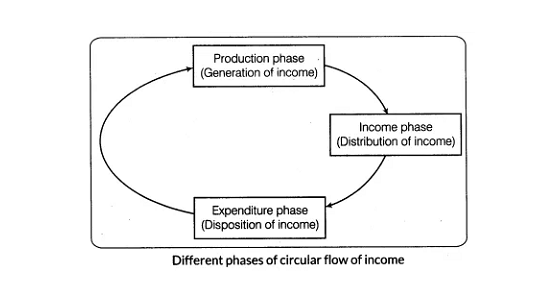
STOCK:
- Stock variable refers to that variable; which is measured at a particular point of time.
- It is static in nature, i.e., it does not change.
- There is no time dimension in stock variables.
- For eg. Distance, Amount of Money, National Wealth, National Capital, Money Supply, Water in Tank etc.
FLOW:
- Flow variable refers to that variable; which is measured over a period. The ‘period of time’ could be a day, a week, a year etc.
- It is dynamic in nature i.e. it can be changed.
- There is time dimension in flow variables
- For example, Speed, Spending of Money, Water in River, Exports, Imports, etc.
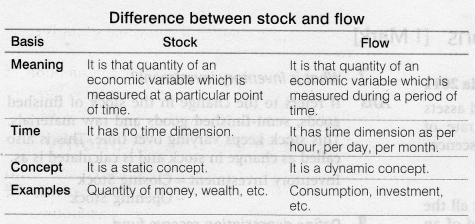
REAL & CASH FLOW
TYPES OF CIRCULAR FLOW
Real Flow: It refers to the flow of factor services (land, labour, capital, and enterprise) from household to firms and the corresponding flow of goods and services from firms to households. It is also known as ‘Physical Flow’.
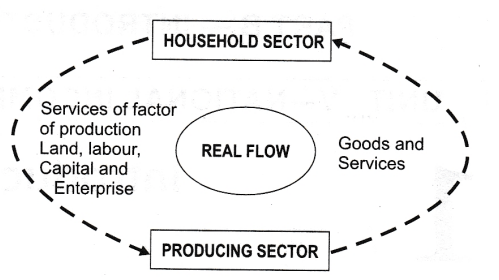
As seen in the above diagram, the households sector provides factor services to the producing sector i.e. firm which, in turn, provide goods and services to them as a reward for their productive services.
Real flow determines the magnitude of growth process in an economy. For example, when more factor services are offered to firms, then volume of production will be more and it speeds up the process of economic growth.
Money Flow: It refers to the flow of factor payments (Rent, wages, interest, and profit) from firms to households for providing factor services and corresponding flow of consumption expenditure from households to firm for purchase of goods and services produced by firm. It is also known as ‘Nominal flow’.
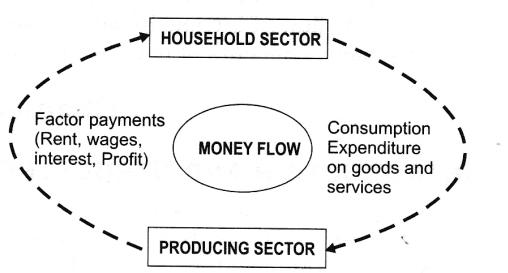
As seen in the above diagram, the producing sector makes factor payments to households for their factor services and households spend this income on purchase of goods and services produced by the firm.
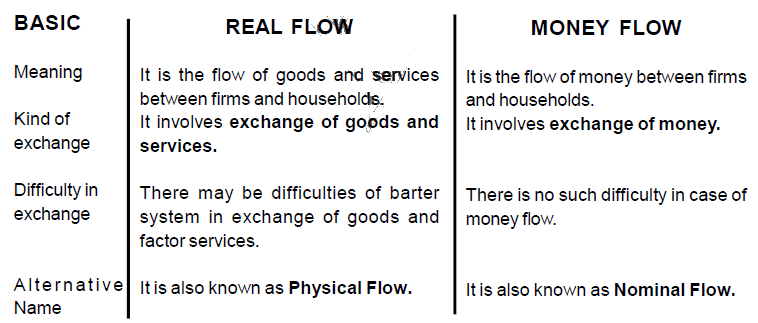
CIRCULAR FLOW OF INCOME - TWO SECTOR ECONOMY MODEL
CIRCULAR FLOW IN A SIMPLE ECONOMY (TWO-SECTOR ECONOMY)
In a simple two-sector economy, there exist only two sectors i.e. household and firms, where households are the owners of factors of production (Land, Labour, Capital, and Enterprise) and consumers of goods & services. Firms produce goods and services and sell them to households.
In order to make our analysis simple, we can make some assumptions:-
- Only two sectors in an economy are there i.e. Households and firms. It means there is no government and foreign sector.
- Households provide factor services to firms only and firms hire factor services from household only.
- The amount received by the household from the firm for providing factor services is used entirely on consumption.
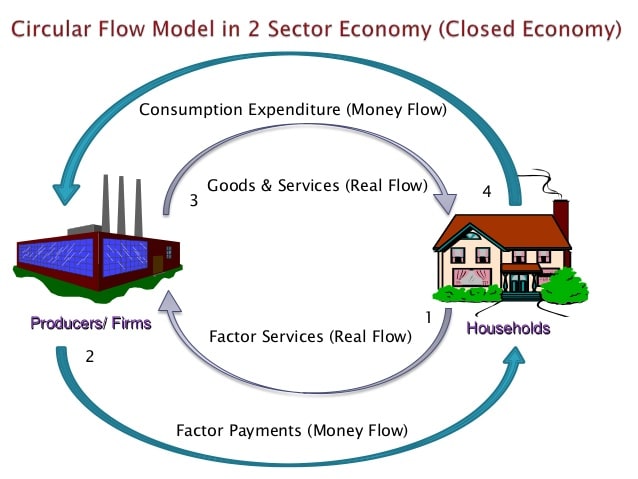
This brings us to the following conclusion.
- There are no savings in the economy, i.e. neither the household saves from their incomes, not the firm saves from their profits.
- In the given diagram, it can be seen that households are providing factor services in exchange for factor payment and firms are providing goods & services to households in exchange for consumption expenditure.
- Total Production = Total Consumption
- Factor Payment = Factor Income
- Consumption Expenditure = Factor Income
- Real Flow = Money Flow
Note: In a circular flow of income, production generates factor income, which is converted into expenditure. This flow of income continues, as production is a continuous activity due to never-ending human wants. It makes the flow of income circular.
Synonyms/Similar terms of this chapter
- Generation Phase - Production Phase
- Distribution Phase - Income Phase
- Disposition Phase - Expenditure Phase
- Real Flow – Physical Flow
- Money Flow – Nominal Flow
DOMESTIC TERRITORY, RESIDENTSHIP, CITIZENSHIP
DOMESTIC TERRITORY
In layman’s language, domestic territory means the political frontiers of a country. However, for national income accounting, it is used in a wider sense.
Definition: Domestic Territory is geographical territory administered by a government within which persons, goods and capital circular freely.
Let us first see what IS not included in a domestic territory:
The domestic territory DOES NOT include-
- Embassies, consulates and military establishment of a foreign country, for example- the American embassy in India is the domestic territory of America and not India
- An international organization like UNO, WHO located within the geographical boundaries of a country
What all is included?
Ship and aircraft owned and operated by normal residents between two countries.
- For example- Planes operated by Air India between London and Paris are part of the domestic territory of India. Similarly, planes operated by Singapore Airways between Indian and Japan are a part of domestic territory of Singapore.
Fishing Vessels, oil and natural gas rigs and floating platforms operated by the residents of a country in the international waters where they have exclusive rights of operation.
- For example, fishing boats operated by Indian anglers in international waters of Indian Ocean will be considered a part of domestic territory of India.
Embassies, consulates and military establishments of country located abroad.
- For example- Indian Embassy in Japan is a part of the domestic territory of India.
NORMAL RESIDENTS
Definition: Normal Residents of a country refers to an individual or institution who ordinarily resides in the country and whose centre of economic interest also lies in that country.
‘Centre of Economic Interest’ implies:
- The resident lives or is located within the domestic Territory.
- The resident carries out basic economic activities of earning, spending, and accumulation from that location.
Following are not included in Normal residents:-
- Foreign Tourists & Visitors
- Foreign staff of Embassies, officials, diplomats and members of the armed forces.
- International Organization like WHO, UNO etc.
- Employers of International Organizations.
- Crewmembers of foreign vessels, commercial travellers and seasonal workers, provided their stay is less than one year.
- Border workers, who cross borders on a regular basis to work in other countries.
CITIZENSHIP AND RESIDENTSHIP
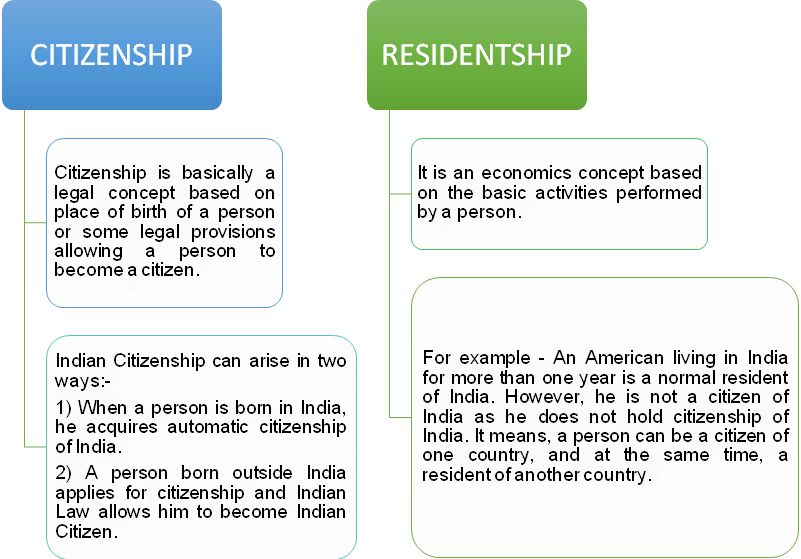
FINAL GOODS & INTERMEDIATE GOODS
TYPES OF GOODS
Final Goods: Final goods refer to those goods, which are used either for consumption or for investment.
For example,
- Goods purchased by consumer households as they are meant for final consumption.
- Goods purchased by firm for capital formation or investment like machinery purchased by a firm.
Intermediate Goods: Intermediate goods refer to those goods which are used either for resale or for further production in the same year.
For example,
- Goods purchased for resale like milk purchased by a dairy shop.
- Goods used for further production like milk used for making sweets.
NOTE: The distinction between intermediate goods and final goods is made based on the use of product and not on the basis of product itself. For example, sugar is an intermediate good when it is used by sweet shop for making sweets. However, if consumers use it, then it becomes a final good.
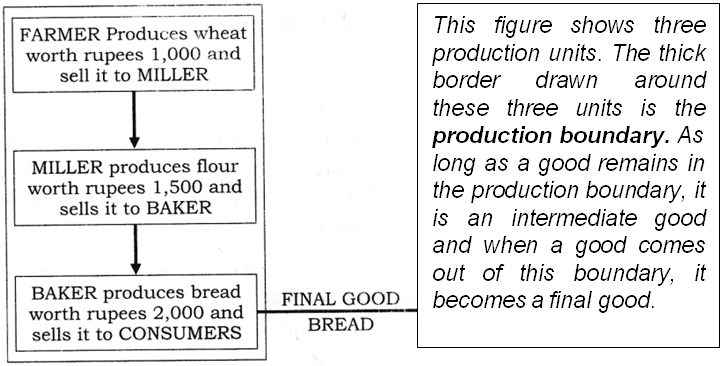
FACTOR INCOME & TRANSFER INCOME
FACTOR INCOME AND TRANSFER INCOME
Factor Income:
Definition: It refers to income received by factor of production (labour, Land, Capital and Enterprise) for rendering factor services in the production process.
- Factor Incomes of normal residents of a country is included in the National Income.
- For example-Rent, Wages, Interest and Profit.
Transfer Income:
Definition: Transfer Income refers to income received without rendering any productive service in return.
- It is unilateral (One-sided) concept.
- As there is no production of goods or services, it is not included in National Income.
- For example- Old age pension, pocket money, unemployment allowance, scholarship etc.
Note: Taxes received by the government are the transfer incomes of the government as they are received without providing any productive service in return. Similarly, subsidies paid by the government are transfer payments of the government.

CONSUMPTION GOODS & CAPITAL GOODS
Final Goods can be further classified into two groups:
- Consumption Goods
- Capital Goods
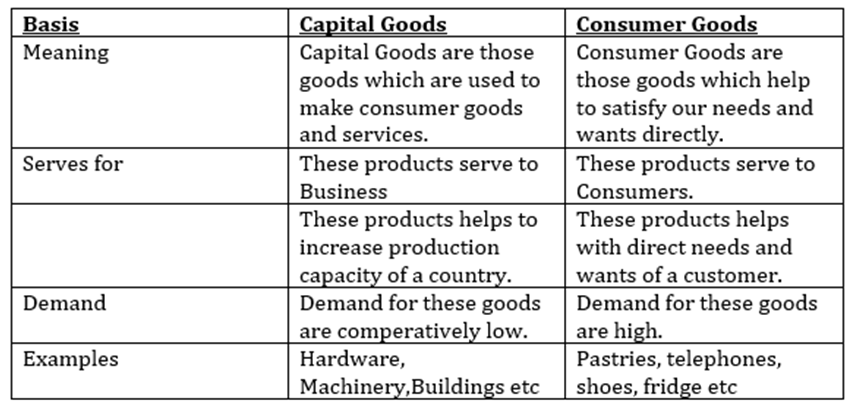
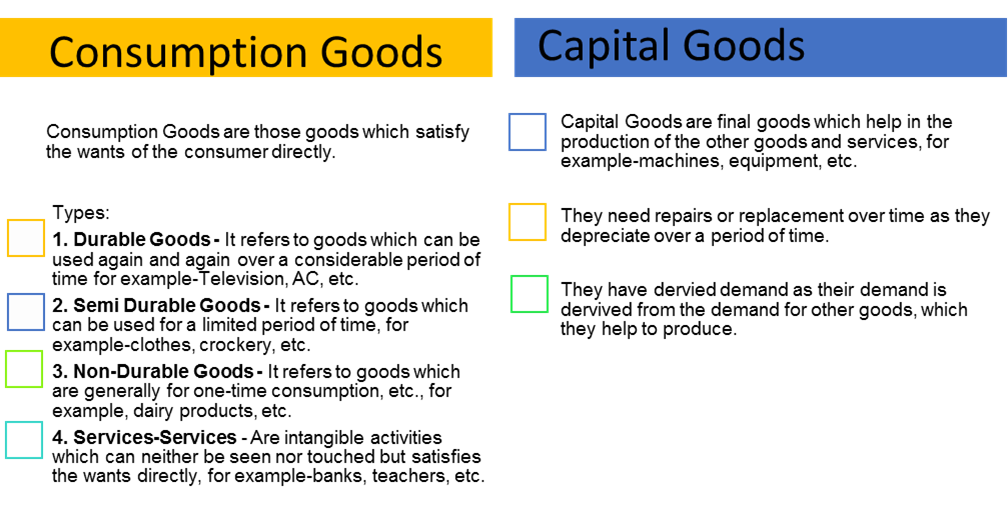
NATIONAL INCOME AGGREGATES
INTRODUCTION
In an economy, different productive units produce various goods and services during a period of one year. Such goods and services cannot be added together in terms of quantity. Therefore, these are expressed in terms of money.
GROSS AND NET
- Gross means the value of product including depreciation.
- Net means the value of product excluding depreciation.
- The difference between these two terms is depreciation.
- Where depreciation is the expected decrease in the value of fixed capital assets due to its general use.
It is the result of production process.
Gross = Net + Depreciation Net = Gross – Depreciation
NATIONAL INCOME AND DOMESTIC INCOME
National Income refers to net money value of all the final goods and services produced by the normal residents of a country during an accounting year.
Domestic Income refers to a total factor income earned by the factor of production within the domestic territory of a country during an accounting year.
The difference between these two incomes is Net Factor Income from abroad (NFIA), which is included in National Income (NY) and excluded from Domestic Income (DY).
Where NFIA is the difference between income earned by normal residents from rest of the world and similar payments made to Non-residents within the domestic territory.
NFIA = Income earned by Residents from rest of the world (ROW) – Payments to
Non-Residents within Domestic territory.
NY = DY + NFIA DY = NY – NFIA
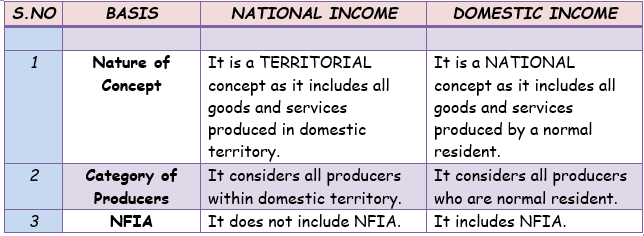
BASIC AGGREGATES OF NATIONAL INCOME
1. Gross Domestic Product at Market Price (GDPMP ):
GDPMP is defined as the gross market value of the final goods and services produced within the domestic territory of a country during an accounting year by all production units.
- ‘Gross’ in GDPMP signifies that depreciation is included, i.e., no provision has been made for depreciation.
- ‘Domestic’ in GDPMP signifies that it includes all the final goods and services produced by all the production units located within the economic territory (irrespective of the fact whether produced by residents or non-residents).
- ‘Market Price’ in GDPMP signifies that indirect taxes are included and subsidies are excluded, i.e., it shows that Net Indirect Taxes (NIT) have been included.
- ‘Product’ in GDPMP signifies that only final goods and services have to be included and intermediate goods should not be included to avoid the double counting.
2. Gross Domestic Product at Factor Cost ( GDPFC):
GDPFC is defined as the gross factor value of the final goods and services produced within the domestic territory of a country during an accounting year by all production units excluding Net Indirect Tax.
GDPFC = GDPMP – Net Indirect Taxes
3. Net Domestic Product at Market Price (NDPMP ).
NDPMP is defined as the net market value of all the final goods and services produced within the domestic territory of a country by its normal residents and non-residents during an accounting year.
NDPMP =GDPMP – Depreciation
4. Net Domestic Product at Factor Cost (NDPFC ).
NDPFC refers to a total factor income earned by the factor of production within the domestic territory of a country during an accounting year.
NDPFC = GDPMP – Depreciation – Net Indirect Taxes NDPFC is also known as Domestic Income or Domestic factor income.
5. Gross National Product at Market Price (GNPMP).
GNPMP refers to market value of all the final goods and services produced by the normal residents of a country during an accounting year.
GNPMP = GDPMP + Net factor income from abroad It must be noted that GNPMP can be less than GDPMP when NFIA is negative. However, GNPMP will be more than GDPMP when NFIA is positive.
6. Gross National Product at Factor Cost (GDPFC ) or Gross National Income
GNPFC refers to gross factor value of all the final goods and services produced by the normal residents of a country during an accounting year.
GDPFC = GNPMP – Net Indirect Taxes
7. Net National Product at Market Price (NNPMP ).
NNPMP refers to net market value of all the final goods and services produced by the normal residents of a country during an accounting year.
NNPMP = GNPMP – Depreciation
8. Net National Product at Factor Cost (NNPFC ) or National Income.
NNPFC refers to net money value of all the final goods and services produced by the normal residents of a country during an accounting year.
NNPFC = GNPMP – Depreciation – Net Indirect Taxes It must be noted that NNPFC is also known as National Income.
RELATIONSHIP BETWEEN ALL AGGREGATES:
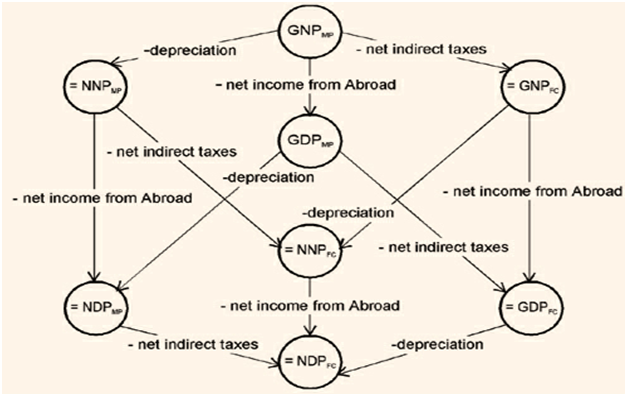
THREE GOLDEN RULES
INVESTMENT
Investment or capital formation refers to addition to the capital stock of an economy. For example-Construction of roads, flyovers, Building, etc.
Investment can be of two forms:
Gross Investment
- Definition: It is an addition to the stock of capital before making allowance for depreciation
Net Investment
- Definition: Net Investment is an actual addition made to the capital stock of the economy in a given period.
- Net Investment = Gross Investment- Depreciation
DEPRECIATION (Consumption of fixed capital)
Definition: It refers to a fall in the value of an asset due to normal wear and tear ,the passage of time or expected obsolescence (change in technology).
NET INDIRECT TAXES (NIT)
- NIT refers to the difference between Indirect Tax and Subsidies.
- Net Indirect Taxes (NIT) = Indirect Tax-Subsidies
Indirect Tax
Definition: Indirect Taxes refers to those taxes, which are imposed by the government on production and sale of goods and services. For example- Goods and Services Tax (GST)
Subsidies
Definition: Subsidies are the ’economic assistance’ given by the government to the firms and households, with a motive of the general welfare. For Example- Subsidy on LPG Gas Cylinders.
Factor Cost
It refers to the amount paid to factors of production for their contribution to the production process.
Market Price
It refers to the Price at which product is actually sold in the market. For example- If price of the LPG cylinder is Rs.1000 and the tax rate is 10%, the price of the cylinder becomes Rs.1100 but a subsidy of Rs.50 is provided by the government hence the final price is Rs.1050.
Here Rs.1000 is factor cost, Rs.1050 is Market Price, Rs.100 is indirect Taxes and Rs.250 is a subsidy.
NET FACTOR INCOME FROM ABROAD (NFIA)
Definition: It refers to the difference between factor income received from the rest of the world and factor income paid to the rest of the world.
NFIA = Factor Income earned from Abroad-Factor Income paid Abroad.
Significance: NFIA is significant to differentiate between ‘domestic income’ and ‘national income’.
National Income= Domestic Income + NFIA.
Components of NFIA
- Net compensation of Employees- It is the difference between income from work received by resident workers living or employed abroad for less than one year & similar payments made to non-resident workers employed domestic territory of the country.
- Net Income from Property and entrepreneurship - It refers to the difference between income from property and entrepreneurship received by residents of the country and similar payments made to Non-residents
- Net Retained earnings - It refers to the difference between retained earnings of resident’s companies located abroad and retained earnings of non-resident companies located within the domestic territory of that country.
NFIA = Net Compensation of Employees + Net Income from Property and Entrepreneurship + Net Retained earnings
Synonyms/Similar terms of this chapter
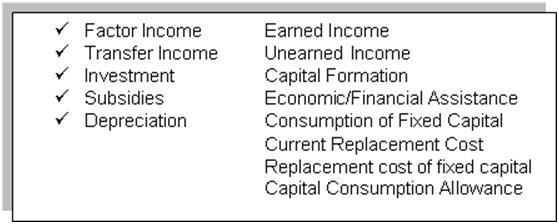
VALUE ADDED METHOD
We have learnt that production gives rise to income, income results in expenditure, which in turn, generates income again.
The National Income of a country can be measured in three different ways:
- Value Added Method
- Income Method
- Expenditure Method
It must be noted that all three methods give the same value of national income because they are used to measure the same physical output at three different phases.
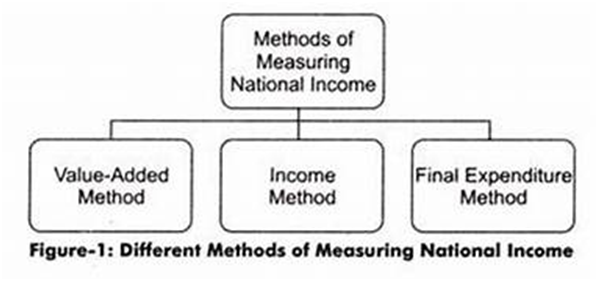
VALUE-ADDED METHOD
This method is used to measure national income in different phases of production in the circular flow. Every individual enterprise adds a certain value to the product when it purchases from some other firm as intermediate goods. When value-added by each and every firm is summed up, we get the value of national income.
- Value Added: Value added is the difference between the value of goods as they leave a stage of production and the cost of the goods as they entered that stage.
Value Added = Value of output - Intermediate consumption
For Example: Suppose a sweet shop owner buys milk worth ₹100 from the milkman. After processing the milk into sweets, he sells it for ₹250.
So, here the milk is intermediate consumption as it was used for making sweets. The sweets which are sold off are output and termed as the value of output.
The difference between this value of output and intermediate consumption is termed as ‘value-added’. Value added by each producing enterprise is known as the Gross Value Added (GVA mp).
Sum total of all GVAmp of all producing enterprises within the domestic territory of a country during one year is equal to GDPmp.
∴ ΣGVAmp = GDPmp
- If the value of intermediate consumption is given, then imports are not included separately as imports are already included in the value of intermediate consumption.
However, if domestic purchases are given, then imports will also be included.
For Example:
Case 1:
- Intermediate Consumption = ₹500
- Imports = ₹200
Here imports would not be included and the value of intermediate consumption is ₹500.
Case 2:
- Purchase of Raw Material from domestic firm=.₹700
- Imports =₹300
Here, the value of intermediate consumption = Purchase of Raw material from domestic firm + Imports =700+300
Intermediate consumption =₹1000
- Value of Output: Value of output refers to the market value of all goods and services produced during a period of one year.
How to calculate the value of output:
- When the entire output is used is sold in an accounting year then the value of output is equal to sales.
- When the entire output is not sold in an accounting year then the value of output is calculated as follows:
Value of output = Sales + change in stock
[Change in stock= Closing stock - Opening stock]
Steps to Calculate National Income by Value Added Method
Step 1- Identify and classify the production units:
The first step is to identify all the producing units into the primary, secondary and tertiary sector.
Step 2- Estimate Gross Domestic Product at Market Price:
Now gross value added to market price (GVAmp) of each sector calculated and the sum total of GVAmp of all sectors gives GDPmp i.e GDPmp= ΣGVA (of all sectors).
Step 3- Calculate Domestic Income (NDPFC)
Now, to calculate NDPFC from GDPmp, we need to subtract both depreciation as well as net indirect taxes i.e NDPFC = GDPmp – Depreciation – Net Indirect Taxes.
Step 4– Calculate National Income (NNPFC)
For calculating NNPFC from NDPFC, NFIA is to be added NNPFC= NDPFC +NFIA
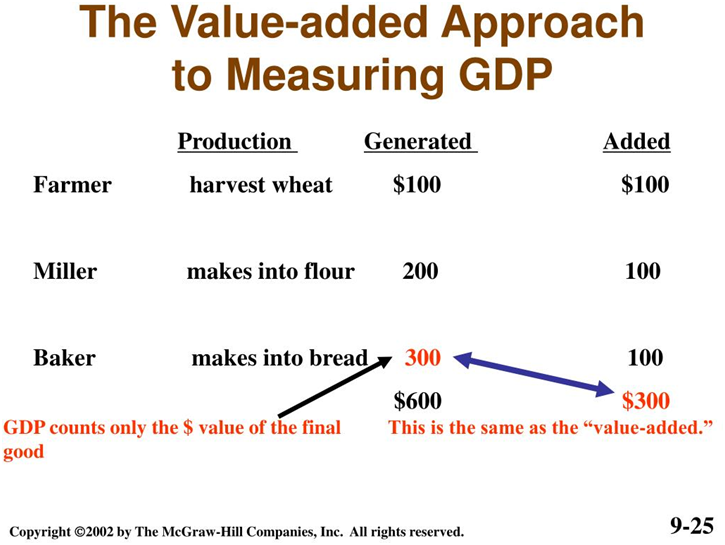
Precautions of Value-Added Method
Intermediate goods are not to be included in National Income - If intermediate goods would be included in National Income it would lead to double-counting, as these are already included in final goods.
Sale and Purchase of Second Hand Goods are not included- Since these goods are already included in the year of manufacture, these are not included again. However, any brokerage or commission earned or paid is to be included while calculation.
Production of services for self-consumption (Domestic Services) are not included: Domestic services like services of Housewife, kitchen gardening etc. are not included in national income as these services never entered market place and it's difficult to find their market value.
Production of goods for self-consumption will be included - It is not included in national income as they contribute to current output. Their value is to be estimated or imputed, as they are not sold in the market.
Change in the stock of goods will be included - Net increase in the stock of inventories will be included in national income as part of capital formation.
The problem of Double Counting:
Double Counting refers to the counting of output more than once while passing through various stages of production.
While calculating national income, the only value of final goods is to be included. The problem of double counting arises when the value of intermediate goods are also included along.
How to avoid Double Counting:
Final Output Method – As per this method, the value of only the final output should be added to determine national income. For example, the value of sweets of Rs 250 sold to final customers should be taken in national income.
Value- Added Method – The value-added in every stage of production is included under this method for calculation of National Income.
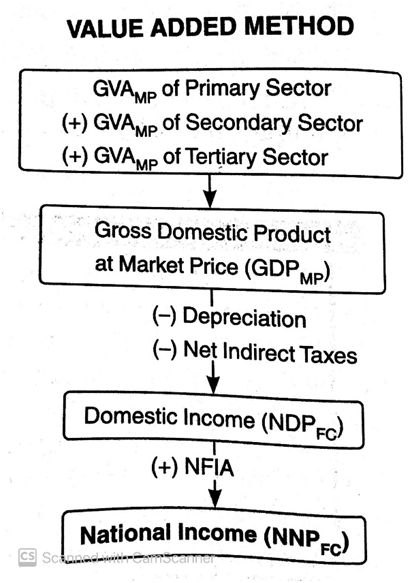
INCOME METHOD
INCOME METHOD
As per this method, all the incomes that accrue to factors of production by way of wages, profits rent, interest, etc. are summed up to obtain the national income.
Components of Factor Income
The following are components of the Income Method. Sum of all the items given below is known as Domestic Income (NDP at FC)
1. Compensation of Employees (COE) –
Definition: COE is the amount paid to employees by employers for rendering productive services. It includes all the benefits received by employees from employers.
- Wages and Salaries in cash- It includes all the benefits, which are in monetary terms like wages, Salaries, bonus, commission, etc.
- Wages and Salaries in kind- it includes all the benefits in non-monetary terms like free house, car, medical facilities, etc.
- Employer’s Contribution to social security schemes – it includes contribution by an employer for social security schemas for Example- provident fund, gratuity, etc.
2. Rent and royalty-
Rent: is income from ownership of land and building. It includes both the actual rent (rent of left out land) as well as imputed rent (rent of self - occupied factors).
Royalty: refers to income received from granting leasing right of sub-soil assets. For example – Royalty from leasing of Iron mine, Gold mine, etc.
3. Interest –
Definition: Interest refers to the amount received from lending funds to a production unit. It involves both actual interest and imputed interest. For example, interest on loans taken for productive services only.
It does not include the following:
- Interest paid by the government on National Debt.
- Interest paid by consumers as such interest is paid on loans taken for consumption purposes.
- Interest paid by one firm to another firm.
4. Profits –
Definition: Profits are excess of revenues over the expenditure of any corporation. It is a residual income.
This profit earned by an entrepreneur can be used for three purposes:
- Corporate Tax – it is a tax paid by a corporate to a government on total profits. It is also known as ‘Profit Tax’ and ‘Business Tax’.
- Dividend – it is divided part of profit given to share - holders. It is also known as distributed profits.
- Retained Earnings – Out of total profit a part is distributed among shareholders and a part is retained in business in business, this is kept for future as Retained Earning. It is also known as undistributed profits, Savings of the Private sector and Reserve & Surplus.
5. Mixed Income –
Definition: It is income generated by people who are self-employed. For example- Barber, farmers, etc. or unincorporated enterprises like the retail trader, small shopkeeper.
Mixed income arises from productive services of self-employed persons, whose income includes wages, rent, interest and profit. These elements cannot be separated from each other. For Example: the income of a doctor running a clinic at his residence.
Steps of Income Method
Step-1 Identify and classify the production units.
All the producing units are classified in Primary, Secondary and tertiary sectors.
Step-2 Estimate the factor income paid by each sector.
Factor incomes paid by each factor are classified under:
- Compensation of Employees,
- Rent and Royalty
- Interest
- Profit
- Mixed income.
Step-3 Calculate Domestic Income (NDP at FC)
When all factor incomes are summed up, we get domestic income (NDP at FC) i.e. NDP at FC= Compensation of Employees + Rent and Royalty + interest +profit + mixed income of self-employed.
Step–4 Calculating National income from Domestic income.
In the final step, we need to add NFIA to domestic income to get National Income.
National Income (NNPFC) = Domestic Income (NDPFC) + NFIA.

PRECAUTIONS OF INCOME METHOD
Transfer Income – Transfer incomes are not included in National income as such incomes are not productive and there is no value addition.
Income from the sale of second-hand goods – Sale of second-hand goods are not included in national income as their sale are already recorded when these were first sold. However, commission, brokerage or any other income is to be recorded.
Income from the sale of shares, bonds and debentures are not included- Such items are not included in national income, as they do not contribute to the current flow of goods and services. However, any brokerage or commission is to be included in national income.
Windfall gains- These are gains like on lottery, horse race, etc are not included as there is no productive activity.
The imputed value of services provided by owners of production unit be the included- Imputed value of owner-occupied houses, interest on own capital, etc are included as it is a productive activity and add to flow of goods and services.
Payments out of past savings- These Payments like death duties, gift tax, interest tax, etc are not included in national income as they are paid out of past savings and do not add to the current flow of goods and services.
EXPENDITURE METHOD
EXPENDITURE METHOD
This method measures national income as the sum total of final expenditure incurred by households, business firms, governments, and foreigners.
This method is also known as ‘Income Disposable Method’.
Components of Final Expenditure:
1. Private final consumption expenditure-
As the name suggests, it is the expenditure made by households and private non –profit sharing institutions on all type of consumer goods.
It includes the following:
- Household final consumption expenditure.
- Private non-profit institutions serving household final consumption expenditure.
- Expenditure made by normal residents abroad during any tour and travel.
However, any expenditure made by foreign tourists in the domestic market would be deducted.
2. Government Final Consumption Expenditure-
It refers to expenditure made by the government on various administrative services like defence, law, and order, education, etc.
It includes the following:
- Intermediate consumption by government.
- Compensation paid by the government.
- Direct purchase from abroad for embassies and consulates located abroad.
However, it does not include the sale of goods and services produced by the general government.
3. Gross Domestic Capital Formation or Gross Investment-
Definition: It refers to the addition to the capital stock of the economy.
Following are components of GDCF:
- Gross fixed capital formation: it refers to expenditure made on purchase to a fixed asset. It includes the following Gross business fixed investment - (expenditure on new plants, machinery, equipment, etc).
- Gross Residential construction investment- (it includes expenditure on purchase of new houses by households).
- Gross public investment – (expenditure on construction of flyovers, bridges, etc by the government).
- Inventory Investment – it refers to the amount by which the firm’s inventories change during a period. it may include stock of raw material, semi-finished goods lying with producers.
It is calculated as the difference between closing stock and opening stock of the year.
- Change in Inventories = closing stock - opening stock.
- GDCF = Gross Fixed Capital Formation+ inventory Investment.
4. Net Exports:
It refers to the difference between exports and imports of a country, during a period of one year. Instead of taking Imports and exports separately, the difference between the two is taken as it is turned as Net Exports.
Net Exports=Export – Import
Steps in Calculating Net Exports
Following steps are involved in the calculation of national income by expenditure method:
Step-1 Identify the economic units incurring final expenditure-
All economic units, which incur final expenditure within the domestic territory, are classified under four groups:
- Households sector
- Govt. Sector
- Producing sector
- Rest of the world sector
Step-2 Classification of Final Expenditure –
Final expenditure by above economic units are estimated and classified under the following heads:
- Private Final Consumption Expenditure (PFCE)
- Government Final Consumption Expenditure (GFCE)
- Gross Domestic Capital Formation (GDCF)
- Net Exports (X-M)
Sum of all of the above components gives GDP.
GDP at MP = PFCE + GFCE + GDCF + (X-M)
Step-3 Calculate Domestic Income (NDPFC)-
Now to calculate NDP at FC from GDP at MP, we need to subtract depreciation and Net Indirect Taxes (NIT).
Step-4. Estimate net factor income from abroad to arrive at national income.
Finally, we add net factor income from abroad to NDPFC in order to get NNPFC (National Income).

Precautions of Expenditure Method
Expenditure on intermediate goods will not be included in national income: As intermediate goods are already included in the value of final expenditure, and if it is included again it will lead to double counting.
Transfer Payments are not included: As these payments are not connected with any productive activity, these are not added while calculating national income.
Purchase of second-hand goods will not be included: As the sale of second - hand goods are already included at the time when they were originally purchased. However, any brokerage or commission on such goods is included as it is the payment made for productive service.
Purchase of financial assets: Transactions relating shares, debentures, bonds etc. are not included, as they do not contribute to the current flow of goods and services. (Commission, brokerage on such transaction to be included)
Expenditure on own account production: Production for self - consumption, imputed value of owner occupied house, free services from general government and private non-profit institutions serving households will be included in national income since these are productive services.

TREATMENT OF DIFFERENT ITEMS IN NATIONAL INCOME
Treatments of different items in National Income
- National Income includes income earned by a normal resident of a country as a reward for their productive services in the current year.
The following items are not included while calculating national income:
Transfer Income and payments like Pension, Scholarship, gifts, etc.
Compulsory Transfer Payments like interest tax, capital gain tax, etc.
Sale and purchase of financial assets.
Windfall gains like lotteries, gambling, etc.
Non - market transactions like kitchen gardening, etc.
Intermediate consumption expenditure like the purchase of raw material by a firm, vegetables purchased by a dairy shop, etc.
Sale or purchase of second- hand goods like sale/purchase of an old house, etc.
Capital loss like the destruction of a building by earthquake or flood etc.
Capital gains like profit due to increase in the price of land, building, shares, etc.
National debt interest or interest paid by households to commercial banks.
Following items are included while calculation of National Income:
Brokerage/Commission on sale/purchase of second- hand goods.
Services provided by the owners of production units like imputed rent of owner’s occupied house interest on own capital etc.
Capital Formation (Investment) like the purchase of machinery by a firm, construction of flyover, bridges, etc.
Payment of bonus, contribution to provident fund by employer etc.
Payment of bus fare by households, examination fees paid by students, payment of telephone bills, etc.
Profit earned by an Indian company from its branches abroad, wages received by Indian employee working abroad, etc.
Free services, (Dispensary, education) by government, government expenditure on street lighting.
Interest on the loan paid by commercial banks.
National Income at Current price and Constant price:
National Income at Current Price: It is the money value of final goods and services produced by normal residents of a country in a year, measured at prices of the current year.
It is also known as ‘Nominal National Income ’. For example – measuring India’s National Income of 2018-19 at prices of 2018-19 or measuring India’s National Income of 2017-18 at prices of 2017-18.
It does not show the true picture of the economic growth of a country as any increase in national income may be due to rise in price level without any change in physical output.
National Income at Constant Price: It is the money value of final goods and services produced by normal residents of a country in a year, measured at price of base - year. Base year is a normal year which is free from price fluctuations). Presently 2011-12 is taken as base year in India.
It is also known as ‘Real National Income’. It shows the true picture of the economic growth of a country as any increase in real national income is due to the increase in output only.
Numerical Example -
National Income at current price and at constant price.
- It can be seen that national income at current price is Rs22000 and at base price is Rs17000. The difference of Rs 5000 is not real. It does not give a true picture of economic growth as the increase is merely due to rise in prices.
Conversion of National income at current price into constant price.
- Conversion of national income at current into constant price can be done using price index, price index is an index number which shows the change in price level between two different time periods.
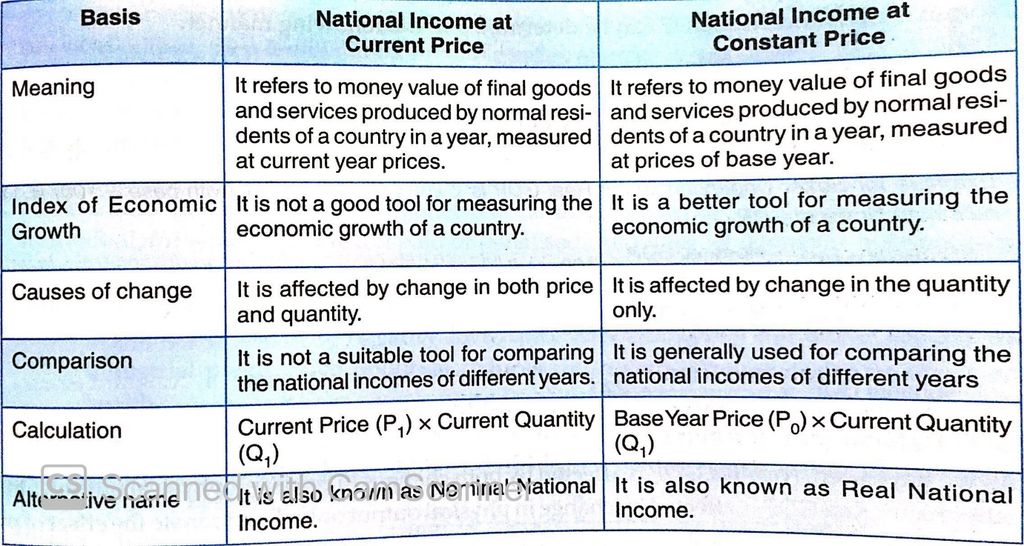
GDP DEFLATOR
Nominal GDP and Real GDP:
1. Nominal GDP or GDP at Current price – When GDP is estimated on the basis of price of the same year, it is called Nominal GDP.
2. Real GDP or GDP at Constant price – When GDP is estimated, based on the price of base year, it is called real GDP.
GDP deflator (Price Index)
Definition: GDP Deflator is one measure of overall price level. It measures the average level of prices of all the goods and services that make up GDP.
GDP Deflator or price index= Nominal GDP/Real GDP *100
Example:
If Nominal GDP is Rs 21000 Cr. and Real GDP is Rs 18000 Cr. Find GDP Deflator.
Ans: GNP Deflator = ₹116.67
Difference between Nominal GDP and Real GDP?
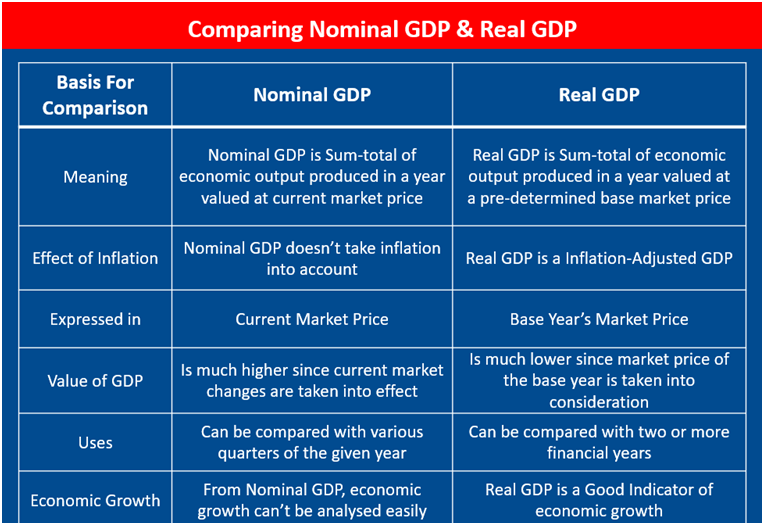
Which is better Nominal GDP or Real GDP?
Real GDP is better because:
- It helps in determining the effect of the increased production of goods and services as it is affected by change in physical output only. On the other hand, Nominal GDP can increase even without any increase in physical output.
- Real GDP is better measure to make periodic comparison in the physical output over different years.
- Real GDP facilitates international comparison of economic performance across the countries.
GDP and Welfare
We generally think that the increase in GDP is good. Increasing GDP is usually considered as one of the Chief goals of government's macroeconomics policy.
Because some serious problem arises when we try to use GDP as a measure of happiness or well-being, we now point out some of the limitations of GDP concept as a measure of welfare.
1. Distribution of GDP - GDP does not take into consideration the income distribution in an economy i.e. gap between rich and poor.
It may be possible that a large part of goods and services are consumed by rich. So, the welfare of the people may not rise as much as the rise in GDP.
2. Change in Price – If GDP is increasing due to increase in price rather than the increase in production, and then it will not be a reliable index of economic welfare.
3. Non-Monetary Exchange – GDP includes only those activities which are in direct monetary terms, so those activities like kitchen gardening which are non – monetary exchanges are not included in GDP due to non - availability of data. However, these activities contribute to economic welfare.
4. Externalities – Externalities refers to those harms or benefits for which a firm is not paid or penalised. It is of two types:
- Positive Externalities – These are the activities which result in benefits to others is termed as positive externalities. For example – Gurudwaras provide free langar for everyone. It increases the welfare of society.
- Negative Externalities – The activities which results in harm to others are termed as negative externalities. Smoking in public will make people smoke passively It reduces the welfare through a negative effect on health.
GDP does not take these externalities into account.
5. Rate of Population Growth – GDP also does not take into account the rate of growth of population i.e. if GDP is increasing due to increase in population. If the rate and growth of population are greater than the rate and growth of GDP, then it will decrease per - availability of goods and services which would adversely affect economic welfare.
BARTER EXCHANGE
INTRODUCTION:
This chapter is a detailed version of barter system and its difficulties, how money has overcome its drawbacks, money supply and its measures.
BARTER SYSTEM & ITS DIFFICULTIES
Barter system
Definition: Barter system refers to exchange of goods for goods. An economy, where there is a direct barter of goods and services, is called a barter economy.
For example, wheat may be exchanged for cloth; house for horses, etc., or a teacher may be paid wheat or rice as a payment for his/her services.
Such exchange exists in the C-C Economy (commodity-to-commodity exchange economy).
Note: In C-C Economy C stands for commodity. C-C economy is the one in which commodities are exchanged for commodities. C-C exchange refers to barter system of exchange. Hence, C-C Economy is an economy dominated by barter system of exchange
Limitations of Barter Exchange:
Lack of double coincidence of wants:
- Barter is possible only if goods produced by two persons are needed by each other, thus it is double coincidence of wants.
- Double coincidence of wants means that goods in possession of two different persons must be useful and needed by each other. It is the basis of barter system, however it is rare for this to happen.
- It is difficult to find such a person every time. In barter system, exchange becomes quite limited.
Lack of store of value:
- It is very difficult to store wealth for future use.
- Most of the goods like wheat, rice, cattle etc. are likely to deteriorate with the passage of time or involve heavy cost of storage.
- Further, the transfer of goods from one place to another place involves huge transport cost.
- Transfer of immovable commodities (such as house, farm, land, etc.) becomes almost impossible.
Absence of common measure of value:
Different commodities are of different values. The value of a good or service means the amount of other goods and services it can be exchanged for in the market. There is no common measure of value under barter system.
In this situation, it is difficult to decide in what proportions are the two goods to be exchanged.
Lack of standard of deferred payment:
- In a barter economy, future payments would have to be stated in terms of specific goods or services. This leads to following problems:
- There could be disagreement regarding the quality of the goods or services to be repaid.
- There would be disagreement regarding which specific commodities would be used for repayment.
Money has overcome the drawbacks of barter system in the following ways:
Barter system makes the exchange process very difficult and highly inefficient.
(a) Medium of exchange
- Under barter system, there is lack of double coincidence of wants.
- With money as a medium exchange individuals can exchange their goods and services for money and then use this money to buy other goods and services according to their needs and conveniences.
- A buyer can buy goods through money and a seller can sell goods for money.
(b) Measure of Value
- Under barter system, there was no common measure of value. Money has also solved this difficulty.
- As Geoffrey Crowther puts it, “Money acts as a standard measure of value to which all other things can be compared.” Money measures the value of economic goods.
- Money works as a common denominator into which the values of all goods and services are expressed.
- When we express the values of a commodity in terms of money, it is called price and by knowing prices of the various commodities, it is easy to calculate exchange ratios between them.
(c) Store of value
- Under barter system, it is very difficult to store wealth for future use.
- Most of the goods are perishable and their storage requires huge space and transportation cost.
- Wealth can be conveniently stored in the form of money.
- Money can be stored without loss in value.
- Money can easily be stored for future use.
(d) Standard of deferred payments
- Under barter system, transactions on deferred payments are not possible.
- With money, the debtors make a promise that they will make payments on some future dates. In these situations, money acts as a standard of deferred payments.
- It has become possible because money has general acceptability, its value is stable, and it is durable and homogeneous.
MONEY
MONEY
Definition: Money is something which is generally acceptable as a medium of exchange and can be converted into other assets without losing its time and value
Characteristics or Features of Money:
- Durability: Money must be durable and not likely to deteriorate rapidly with
frequent handling. Currency notes and coins are being used repeatedly and shall
continue to do so for many years. - Medium of exchange: Money is the thing that acts as a medium of exchange for the sale and purchase of goods and services.
- Weight: Money must be light in weight. Paper money is better than metal coins because it is light in weight.
- Measure of value: It not only serves as medium of exchange but also acts as a measure of value. The value of all the goods and services is expressed in terms of money.
Important points about money:
- Legal definition of money: Legally, money is anything proclaimed by law as a medium of exchange. Paper notes and coins (together called currency) is money as a matter of law.
- FIAT Money: It is defined as a money which is under the ‘FIAT’ (order/authority) of the government to act as a money.
- Functional definition of money: Functional definition of money refers to money as anything that performs four basic functions. (Medium of exchange, standard unit of value, standard of deferred payments, store of value)
- Narrow definition of money: Functional definition of money is a narrow definition of money. It includes only notes, coins and demand deposits as money.
- Broad definition of money: A broad definition of money also includes time deposits/ term deposits with the banks or post offices as a component of money.
MONEY SUPPLY
Money Supply & Measures of Money Supply
- Money supply:
Definition: The volume of money held by the public at a point of time, in an economy, is referred to as the money supply. Money supply is a stock concept.
- Measures of money supply:
On the recommendation of the second working group on money supply, the RBI presented four measures of money supply in its 1977 issues of RBI Bulletin, namely M1, M2, M3 and M4.
Measures of M1 include:
- Currency notes and coins with the public (excluding cash in hand of all commercial banks) [C]
- Demand deposits of all commercial and co-operative banks excluding inter-bank deposits. (DD)
- Where demand deposits are those deposits which can be withdrawn by the depositor at any time by means of cheque. No interest is paid on such deposits.
- (c) Other deposits with RBI [O.D]
M1 = C + DD + OD
Where, Other deposits are the deposits held by the RBI of all economic units except the government and banks. OD includes demand deposits of semi¬government public financial institutions (like IDBI, IFCI, etc.), foreign central banks and governments, the International Monetary Fund, the World Bank, etc.
Measures of M2:
- M1 [C + DD + OD]
- Post office saving deposits
Measures of M3:
- M1
- Time deposits of all commercial and co-operative banks.
Where, Time deposits are the deposits that cannot be withdrawn before the expiry of the stipulated time for which deposits are made. Fixed deposit is an example of time deposit.
Measures of M4
- M3
- Total deposits with the post office saving organization (excluding national savings certificates).
- High-powered money: High-powered money is money produced by the RBI and the government. It consists of two things: (a) currency held by the public and (b) Cash reserves with the banks.
CONCLUSION
- Barter system: Barter system of exchange is a system in which goods are exchanged for goods.
- Double coincidence of wants: It means that goods in possession of two different persons must be useful and needed by each other.
- Money: Money is something which is generally acceptable as a medium of exchange and can be converted into other assets without loosing its time and value.
- Legal definition of money: Legally, money is anything proclaimed by law as a medium of exchange. Paper notes and coins (together called currency) is money as a matter of law.
- FIAT Money: It is defined as a money which is under the ‘FIAT’ (order/authority) of the government to act as a money.
- Functional definition of money: Functional definition of money refers to money as anything that performs four basic functions. (Medium of exchange, standard unit of value, standard of deferred payments, store of value)
- Narrow definition of money: Functional definition of money is a narrow definition of money. It includes only notes, coins and demand deposits as money.
- Broad definition of money: A broad definition of money also includes time deposits/ term deposits with the banks or post offices as a component of money.
- Money Supply: The stock of money held by the public at a point of time, in an economy, is referred to as the money supply. Money supply is a stock concept.
- High-powered money: It is money produced by the RBI and the government. It consists of two things: (i) currency held by the public and (ii) Cash reserves with the banks.
- Demand deposits: These are the deposits that can be withdrawn by the depositor at any time by means of cheque. No interest is paid on such deposits.
- Time deposits: These are the deposits that cannot be withdrawn before the expiry of the stipulated time for which deposits are made. Fixed deposit is an example of time deposit.
- Other deposit measures of M1: Other deposits are the deposits held by the RBI of all economic units except the government and banks. OD includes demand deposits of semi-government public financial institutions (like IDBI, IFCI, etc.), foreign central banks and governments, the International Monetary Fund, the World Bank, etc
MONEY SUPPLY
Money Supply & Measures of Money Supply
Money supply:
Definition: The volume of money held by the public at a point of time, in an economy, is referred to as the money supply. Money supply is a stock concept.
Measures of money supply:
On the recommendation of the second working group on money supply, the RBI presented four measures of money supply in its 1977 issues of RBI Bulletin, namely M1, M2, M3 and M4.
Measures of M1 include:
Currency notes and coins with the public (excluding cash in hand of all commercial banks) [C]
Demand deposits of all commercial and co-operative banks excluding inter-bank deposits. (DD)
Where demand deposits are those deposits which can be withdrawn by the depositor at any time by means of cheque. No interest is paid on such deposits.
(c) Other deposits with RBI [O.D]
M1 = C + DD + OD
Where, Other deposits are the deposits held by the RBI of all economic units except the government and banks. OD includes demand deposits of semi¬government public financial institutions (like IDBI, IFCI, etc.), foreign central banks and governments, the International Monetary Fund, the World Bank, etc.
Measures of M2:
- M1 [C + DD + OD]
- Post office saving deposits
Measures of M3:
- M1
- Time deposits of all commercial and co-operative banks.
Where, Time deposits are the deposits that cannot be withdrawn before the expiry of the stipulated time for which deposits are made. Fixed deposit is an example of time deposit.
Measures of M4:
- M3
- Total deposits with the post office saving organization (excluding national savings certificates).
- High-powered money: High-powered money is money produced by the RBI and the government. It consists of two things: (a) currency held by the public and (b) Cash reserves with the banks
CONCLUSION
- Barter system: Barter system of exchange is a system in which goods are exchanged for goods.
- Double coincidence of wants: It means that goods in possession of two different persons must be useful and needed by each other.
- Money: Money is something which is generally acceptable as a medium of exchange and can be converted into other assets without loosing its time and value.
- Legal definition of money: Legally, money is anything proclaimed by law as a medium of exchange. Paper notes and coins (together called currency) is money as a matter of law.
- FIAT Money: It is defined as a money which is under the ‘FIAT’ (order/authority) of the government to act as a money.
- Functional definition of money: Functional definition of money refers to money as anything that performs four basic functions. (Medium of exchange, standard unit of value, standard of deferred payments, store of value)
- Narrow definition of money: Functional definition of money is a narrow definition of money. It includes only notes, coins and demand deposits as money.
- Broad definition of money: A broad definition of money also includes time deposits/ term deposits with the banks or post offices as a component of money.
- Money Supply: The stock of money held by the public at a point of time, in an economy, is referred to as the money supply. Money supply is a stock concept.
- High-powered money: It is money produced by the RBI and the government. It consists of two things: (i) currency held by the public and (ii) Cash reserves with the banks.
- Demand deposits: These are the deposits that can be withdrawn by the depositor at any time by means of cheque. No interest is paid on such deposits.
- Time deposits: These are the deposits that cannot be withdrawn before the expiry of the stipulated time for which deposits are made. Fixed deposit is an example of time deposit.
- Other deposit measures of M1: Other deposits are the deposits held by the RBI of all economic units except the government and banks. OD includes demand deposits of semi-government public financial institutions (like IDBI, IFCI, etc.), foreign central banks and governments, the International Monetary Fund, the World Bank, etc
FUNCTIONS OF MONEY
Functions of Money:
We can conclude these four functions under the following two categories:
1 - Primary function
2 - Secondary function
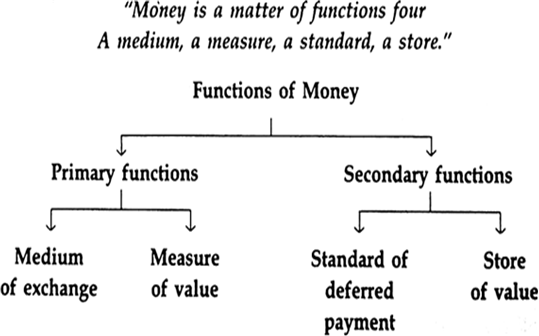
Primary function or Main function:
The primary function includes the most important functions of money, which it must perform in an economic system irrespective of time and place. The following two functions are included under this category.
(i) Medium of exchange
- Money when used as a medium of exchange helps to eliminate the basic limitation of barter trade, that is, the lack of double coincidence of wants.
- Individuals can exchange their goods and services for money and then can use this money to buy other goods and services according to their needs and convenience.
- Thus, the process of exchange shall have two parts: a sale and a purchase.
- The ease at which money is converted into other goods and services is called “liquidity of money”.
(ii) Measure of value /unit of account
- Another important function of money is that it serves as a common measure of value or a unit of account.
- Under barter economy, there was no common measure of value in which the values of different goods could be measured and compared with each other. Money has also solved this difficulty.
- As Geoffrey Crowther puts it, “Money acts as a standard measure of value to which all other things can be compared.” Money measures the value of economic goods.
- Money works as a common denominator into which the values of all goods and services are expressed.
- When we express the values of a commodity in terms of money, it is called price and by knowing prices of the various commodities, it is easy to calculate exchange ratios between them.
Secondary Functions:
(i) Standard of deferred payments
- Credit has become the life and blood of a modern capitalist economy.
- In millions of transactions, instant payments are not made.
- The debtors make a promise that they will make payments on some future date. In those situations, money acts as a standard of deferred payments.
- It has become possible because money has general acceptability, its value is stable, it is durable and homogeneous.
(ii) Store of value
- Wealth can be conveniently stored in the form of money. Money can be stored without loss in value.
- Savings are secured and can be used whenever there is a need.
- In this way, money acts as a bridge between the present and the future.
- Money means goods and services. Thus, money serves as a store of value.
- It is also known as asset function of money.
EVOLUTION OF MONEY
EVOLUTION OF MONEY
Money has evolved through different stages according to the time, place and circumstances. It developed through the following stages:
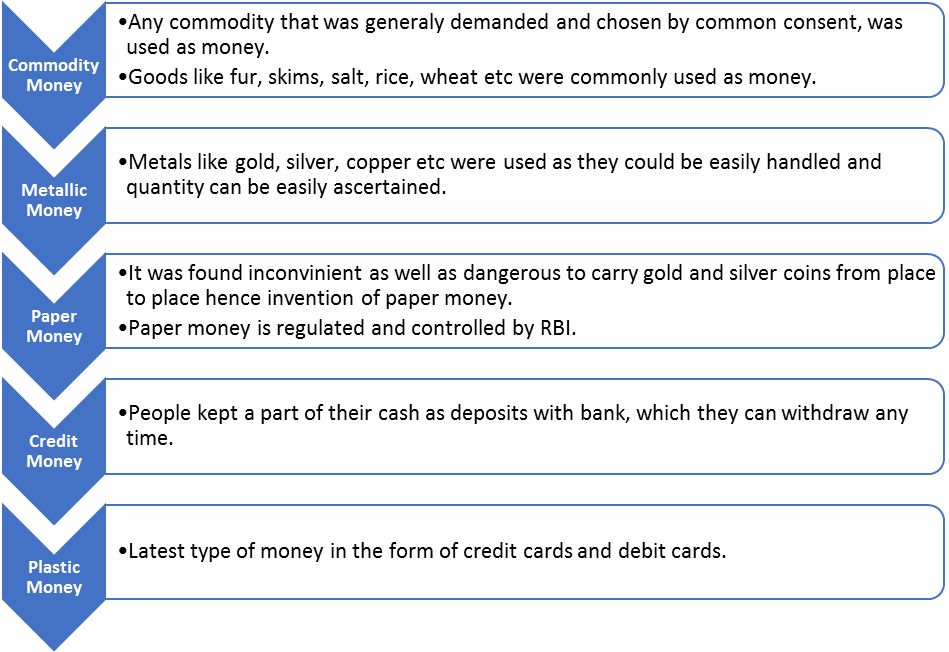
DEMAND FOR MONEY
DEMAND FOR MONEY
There are three main motives, for which money is wanted by the people:
Transaction Motive:
It refers to demand for money for conducting day-to-day transactions. This motive can be looked at from the perspective of consumers, who want income to meet their household expenditure (income motive) and from the perspective of businesspersons, who require money to carry on their business activities (business motive). The transaction motive relates to demand for money to meet the current transactions of individuals and business units.
Precautionary Motive:
It refers to the desire of people to hold cash balances for unforeseen contingencies. People wish to hold some money to provide for the risk of unforeseen events like sickness, accident, etc. The amount of money held under this motive, depends on the nature of individual and on the conditions in which he lives. The demand of money for precautionary balances is also closely related to the level of income. Higher the level of income, more will be the cash balances
Speculative Motive:
It refers to desire of the holder to keep cash balance as an alternative to financial assets like bonds. Under speculative motive, it is presumed that people can hold their wealth either in the form of bonds or in the form of cash balances. The decisions regarding holding of bonds or cash balances depend upon the expectations about changes in the rate of interest or capital value of assets (bonds) in future. The interest rate varies inversely with the market value of securities (bonds), i.e. when interest rate rises, market value of bonds falls. Hence, demand for money for speculative motive becomes less at high interest rates and becomes large at low interest rates.
COMMERCIAL BANK
COMMERCIAL BANK
A commercial bank is a kind of financial institution that carries all the operations related to deposit and withdrawal of money for the general public, providing loans for investment, and other such activities. These banks are profit-making institutions and do business only to make a profit.
The two primary characteristics of a commercial bank are lending and borrowing. The bank receives the deposits and gives money to various projects to earn interest (profit). The rate of interest that a bank offers to the depositors is known as the borrowing rate, while the rate at which a bank lends money is known as the lending rate.
Function of Commercial Bank:
The functions of commercial banks are classified into two main divisions.
(a) Primary functions
Accepts deposit: The bank takes deposits in the form of saving, current, and fixed deposits. The surplus balances collected from the firm and individuals are lent to the temporary requirements of the commercial transactions.
Provides loan and advances: Another critical function of this bank is to offer loans and advances to the enterpreneurs and business people and collect interest. For every bank, it is the primary source of making profits. In this process, a bank retains a small number of deposits as a reserve and offers (lends) the remaining amount to the borrowers in demand loans, overdraft, cash credit, short-run loans, and more such banks.
Credit cash: When a customer is provided with credit or loan, they are not provided with liquid cash. First, a bank account is opened for the customer and then the money is transferred to the account. This process allows the bank to create money.
(b) Secondary functions
Discounting bills of exchange: It is a written agreement acknowledging the amount of money to be paid against the goods purchased at a given point of time in the future. The amount can also be cleared before the quoted time through a discounting method of a commercial bank.
Overdraft facility: It is an advance given to a customer by keeping the current account to overdraw up to the given limit.
Purchasing and selling of the securities: The bank offers you with the facility of selling and buying the securities.
Locker facilities: A bank provides locker facilities to the customers to keep their valuables or documents safely. The banks charge a minimum of an annual fee for this service.
Paying and gathering the credit: It uses different instruments like a promissory note, cheques, and bill of exchange.
CREDIT CREATION
Money Creation / Credit Creation
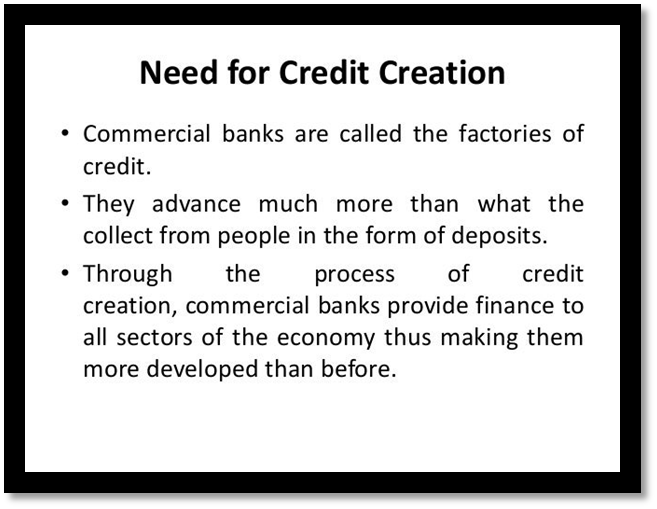
Let us assume:
The entire commercial banking system is one unit. Let us call this one unit simply “banks’.
All receipts and payments in the economy are routed through the banks. One who makes payment does it by writing cheque. The one who receives payment deposits the same in his deposit account.
Suppose initially people deposit Rs.1000. The banks use this money for giving loans. But the banks cannot use the whole of deposit for this purpose. It is legally compulsory for the banks to keep a certain minimum fraction of these deposits as cash. The fraction is called the Legal Reserve Ratio (LRR). The LRR is fixed by the Central Bank. It has two components. A part of the LRR is to be kept with the Central bank and this part ratio is called the Cash Reserve Ratio (CRR). The other part is kept by the banks with themselves and is called the Statutory Liquidity Ratio.
Let us now explain the process, suppose the initial deposits in banks is Rs.1000 and the LRR is 10 percent. Further, suppose that banks keep only the minimum required, i.e., Rs.100 as cash reserve, banks are now free to lend the remainder Rs.900. Suppose they lend Rs.900. What banks do to open deposit accounts in the names of the borrowers who are free to withdraw the amount whenever they like.
Let us now suppose they withdraw the whole of amount for making payments.
Now, since all the transactions are routed through the banks, the money spent by the borrowers comes back into the banks into the deposit accounts of those who have received this payment. This increases demand deposit in banks by 900. It is 90 per cent of the initial deposit. These deposits of Rs.900 have resulted on account of loans given by the banks. In this sense the banks are responsible for money creation. With this round, increased in total deposits are now Rs.1900 (1000 + 900).
When banks receive new deposit of Rs.900, they keep 10% of it as cash reserves and use the remaining Rs.810 for giving loans. The borrowers use these loans for making payments. The money comes back into the accounts of those who have received the payments. Bank deposits again rise, but by a smaller amount of Rs.810. It is 90 per cent of the last deposit creation. The total deposits now increase to Rs.2710 (=1000 + 900 + 810). The process does not end here.
The deposit creation continues in the above manner. The deposits go on increasing round after round but Deposit Creation by Commercial Banks increases each time by only 90 per cent of the last round deposits. At the same time, cash reserves go on increasing, each time 90 per cent of the last cash reserve. The deposit creation comes to end when the total cash reserves become equal to the initial deposit. The total deposit creation comes to Rs.10000, ten times the initial deposit as shown in the table.
Deposit Creation By Commercial Banks
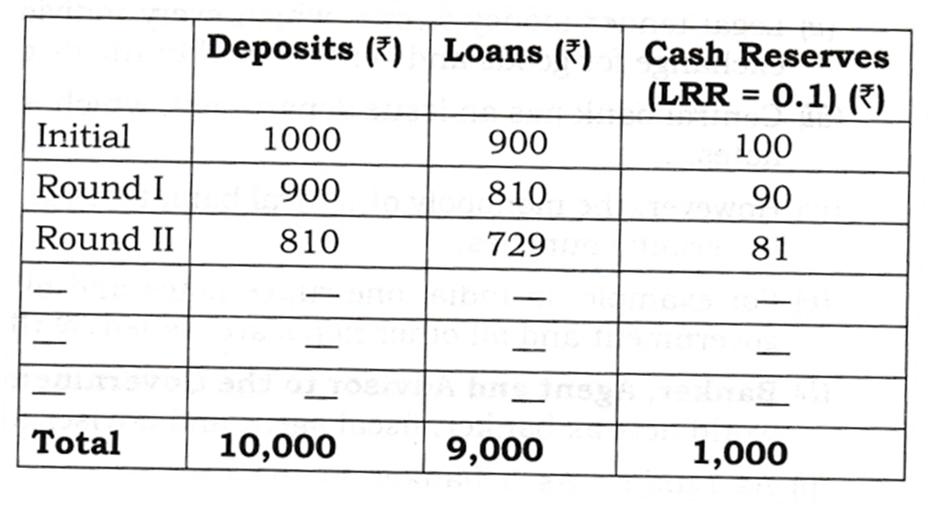
It can also be explained with the help of the following formula:
Money Multiplier = 1/LRR = 1/0.1 = 10
The total money creation thus,
Money creation = Initial deposit*1/LRR = 10,000
Note that lower the LRR, higher the money multiplier and more the money creation. If the LRR = 5% = 0.5, the money multiplier = 2(1/0.05). If the LRR = 20%, the money multiplier is
Banks are required to keep only a fraction of deposits as cash reserves because of the following two reasons:
First, the banking experience has revealed that not all depositors approach the banks for withdrawal of money at the same time and also that normally they withdraw a fraction of deposits.
Secondly, there is a constant flow of new deposits into the banks. Therefore to meet the daily demand for withdrawal of cash, it is sufficient for banks to keep only a fraction of deposits as a cash reserve.
When the primary cash deposit in the banking system leads to multiple expansion in the total deposits, it is known as money multiplier or credit multiplier.
CENTRAL BANK
CENTRAL BANK
Definition: The central bank is an apex body that controls, operates, regulates and directs the entire banking and monetary structure of the country.
It is known as apex as it occupies the top most position in the monetary and banking system of the country. India’s central bank is the Reserve Bank of India.
Functions of Central Bank:
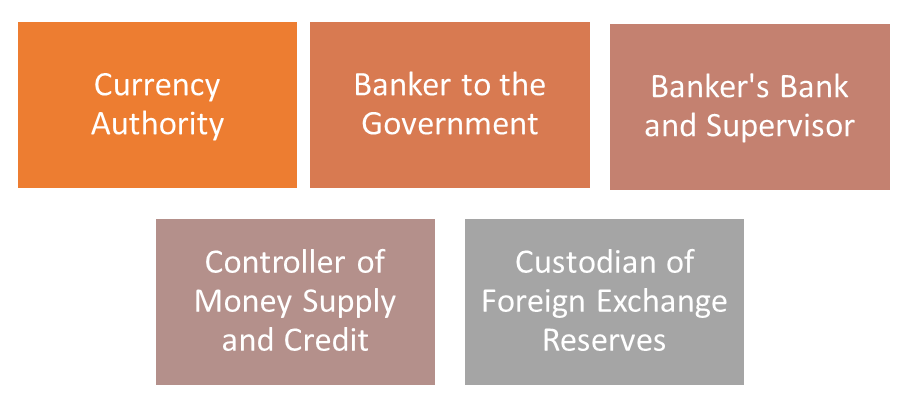
1. Currency Authority:
- The central bank has the sole monopoly to issue currency notes. Commercial banks cannot issue currency notes. Currency notes issued by the central bank are the legal tender money.
- Legal tender money is one, which every individual is bound to accept by law in exchange for goods and services and in the discharge of debts.
- Central bank has an issue department, which is solely responsible for the issue of notes.
However, the monopoly of central bank to issue the currency notes may be partial in certain countries.
For example, in India, the government issues one-rupee notes and all types of coins and all other notes are issued by the Reserve Bank of India.
2. Banker to the Government:
- Central bank everywhere in the world acts as banker, fiscal agent and adviser to their respective government.
(I) As Banker:
As a banker to the government, the central bank performs same functions as performed by the commercial banks to their customers.
- It receives deposits from the government and collects cheques and drafts deposited in the government account.
- It provides cash to the government as resumed for payment of salaries and wages to their staff and other cash disbursements.
- It makes payments on behalf of the government.
- It also advances short-term loans to the government.
- It supplies foreign exchange to the government for repaying external debt or making other payments.
(ii) As Fiscal Agent:
- As a fiscal agent, it manages the public debt.
- It collects taxes and other payments on behalf of the government.
- It represents the government in the international financial institutions (such as World Bank, International Monetary Fund, etc.) and conferences.
(iii) As Adviser:
- The central bank also acts as the financial adviser to the government.
- It gives advice to the government on all financial and economic matters such as deficit financing, devaluation of currency, trade policy, foreign exchange policy, etc.
3. Banker’s Bank and Supervisor:
(a) Banker’s Bank: Central bank acts as the banker to the banks in three ways:
- Custodian of the cash reserves of the commercial banks;
- As the lender of the last resort; and
- As clearing agent.
(i) As a custodian of the cash reserves of the commercial banks, the central bank maintains the cash reserves of the commercial banks. Every commercial bank has to keep a certain percent of its cash reserves with the central bank by law.
(ii) As Lender of the Last Resort,
- As banker to the banks, the central bank acts as the lender of the last resort.
- In other words, in case the commercial banks fail to meet their financial requirements from other sources, they can, as a last resort, approach to the central bank for loans and advances.
- The central bank assists such banks through discounting of approved securities and bills of exchange.
(iii) As Clearing Agent,
- Since it is the custodian of the cash reserves of the commercial banks, the central bank can act as the clearinghouse for these banks.
- Since all banks have their accounts with the central bank, the central bank can easily settle the claims of various banks against each other simply by book entries of transfers from and to their accounts.
- This method of settling accounts is called the Clearing House Function of the central bank.
(b) Supervisor
- The Central Bank supervises, regulates and controls the commercial banks.
- The regulation of banks may be related to their licensing, branch expansion, liquidity of assets, management, amalgamation (merging of banks) and liquidation (the winding of banks).
- The control is exercised by periodic inspection of banks and the returns filed by them.
4. Controller of Money Supply and Credit:
Principal instruments of Monetary Policy or credit controls of the Central Bank of a country are broadly classified as:
- Quantitative Instruments or General Tools
- Qualitative Instruments or Selective Tools.
(a) Quantitative Instruments or General Tools of Monetary Policy: These are the instruments of monetary policy that affect overall supply of money/credit in the economy. These instruments do not direct or restrict the flow of credit to some specific sectors of the economy.
(i) Bank Rate (Discount Rate)
- Bank rate is the rate of interest at which central bank lends to commercial banks without any collateral (security for purpose of loan). The thing, which has to be remembered, is that central bank lends to commercial banks and not to public.
- In a situation of excess demand leading to inflation,
- Central bank raises bank rate that discourages commercial banks in borrowing from central bank, as it will increase the cost of borrowing of commercial bank.
- It forces the commercial banks to increase their lending rates, which discourages borrowers from taking loans, which discourages investment.
- Again high rate of interest induces households to increase their savings by restricting expenditure on consumption.
Thus, expenditure on investment and consumption is reduced, which will control the excess demand.
In a situation of deficient demand leading to deflation,
- Central bank decreases bank rate that encourages commercial banks in borrowing from the central bank as it will decrease the cost of borrowing of commercial bank.
- Decrease in bank rate makes commercial bank to decrease their lending rates, which encourages borrowers from taking loans, which encourages investment.
- Again low rate of interest induces households to decrease their savings by increasing expenditure on consumption.
Thus, expenditure on investment and consumption increase, which will control the deficient demand.
(ii) Repo Rate
- Repo rate is the rate at which commercial bank borrow money from the central
- bank for short period by selling their financial securities to the central bank.
- These securities are pledged as a security for the loans.
- It is called Repurchase rate as this involves commercial bank selling securities
- to RBI to borrow the money with an agreement to repurchase them at a later
- date and at a predetermined price.
Therefore, keeping securities and borrowing is repo rate.
In a situation of excess demand leading to inflation,
- Central bank raises repo rate that discourages commercial banks in borrowing from central bank as it will increase the cost of borrowing of commercial bank.
- It forces the commercial banks to increase their lending rates, which discourages borrowers from taking loans, which discourages investment.
- Again high rate of interest induces households to increase their savings by restricting expenditure on consumption.
Thus, expenditure on investment and consumption is reduced, which will control the excess demand.
In a situation of deficient demand leading to deflation,
- Central bank decreases Repo rate that encourages commercial banks in borrowing from central bank, as it will decrease the cost of borrowing of commercial bank.
- Decrease in Repo rate makes commercial bank to decrease their lending rates, which encourages borrowers from taking loans, which encourages investment.
- Again low rate of interest induces households to decrease their savings by increasing expenditure on consumption.
Thus, expenditure on investment and consumption increase, which will control the deficient demand.
(iii) Reverse Repo Rate
- It is the rate at which the Central Bank (RBI) borrows money from commercial bank.
- In a situation of excess demand leading to inflation, Reverse repo rate is increased, it encourages the commercial bank to park their funds with the central bank to earn higher return on idle cash. It decreases the lending capability of commercial banks, which controls excess demand.
- In a situation of deficient demand leading to deflation, Reverse repo rate is decreased; it discourages the commercial bank to park their funds with the central bank. It increases the lending capability of commercial banks, which controls deficient demand.
(iv) Open Market Operations (OMO)
- It consists of buying and selling of government securities and bonds in the open market by Central Bank.
- In a situation of excess demand leading to inflation, central bank sells government securities and bonds to commercial bank. With the sale of these securities, the power of commercial bank of giving loans decreases, which will control excess demand.
- In a situation of deficient demand leading to deflation, central bank purchases.
- Government securities and bonds from commercial bank. With the purchase of these securities, the power of commercial bank of giving loans increases, which will control deficient demand.
(v) Varying Reserve Requirements
- Banks are obliged to maintain reserves with the central bank, which is known as legal reserve ratio. It has two components. One is the Cash Reserve Ratio or CRR and the other is the SLR or Statutory Liquidity Ratio.
- Cash Reserve Ratio: It refers to the minimum percentage of a bank’s total deposits, which it is required to keep with the central bank. Commercial banks have to keep with the central bank a certain percentage of their deposits in the form of cash reserves as a matter of law.
For example, if the minimum reserve ratio is 10% and total deposits of a certain bank is Rs. 100 crore, it will have to keep Rs. 10 crore with the Central Bank.
- In a situation of excess demand leading to inflation, Cash Reserve Ratio (CRR) is raised to 20 per cent, the bank will have to keep Rs.20 crore with the Central Bank, which will reduce the cash resources of commercial bank and reducing credit availability in the economy, which will control excess demand.
- In a situation of deficient demand leading to deflation, cash reserve ratio (CRR) falls to 5% the bank will have to keep Rs. 5 crore with the central bank, which will increase the cash resources of commercial bank and increasing credit availability in the economy, which will control deficient demand.
(vi) The Statutory Liquidity Ratio (SLR)
- It refers to minimum percentage of net total demand and time liabilities, which commercial banks are required to maintain with themselves.
- In a situation of excess demand leading to inflation, the central bank increases statutory liquidity ratio (SLR), which will reduce the cash resources of commercial bank and reducing credit availability in the economy.
- In a situation of deficient demand leading to deflation, the central bank decreases statutory liquidity ratio (SLR), which will increase the cash resources of commercial bank and increases credit availability in the economy.
It may consist of:
(1) Excess reserves
(2) Unencumbered (are not acting as security for loans from the Central Bank) government and other approved securities (securities whose repayment is guaranteed by the government); and
(3) Current account balances with other banks.
(b) Qualitative Instruments or Selective Tools of Monetary Policy: These instruments are used to regulate the direction of credit. They are as under:
Imposing margin requirement on secured loans
- Business and traders get credit from commercial bank against the security of their goods. Bank never gives credit equal to the full value of the security. It always pays less value than the security.
- So, the difference between the value of security and value of loan is called
- marginal requirement.
- In a situation of excess demand leading to inflation, central bank raises marginal requirements. This discourages borrowing because it makes people gets less credit against their securities.
- In a situation of deficient demand leading to deflation, central bank decreases marginal requirements. This encourages borrowing because it makes people get more credit against their securities.
Moral Suasion
- Moral suasion implies persuasion, request, informal suggestion, advice and appeal by the central banks to commercial banks to cooperate with general monetary policy of the central bank.
- In a situation of excess demand leading to inflation, it appeals for credit contraction.
- In a situation of deficient demand leading to deflation, it appeals for credit expansion.
Selective Credit Controls (SCCs)
- In this method, the central bank can give directions to the commercial banks not to give credit for certain purposes or to give more credit for particular purposes or to the priority sectors.
- In a situation of excess demand leading to inflation, the central bank introduces rationing of credit in order to prevent excessive flow of credit, particularly for speculative activities. It helps to wipe off the excess demand.
- In a situation of deficient demand leading to deflation, the central bank withdraws rationing of credit and make efforts to encourage credit.
5. Custodian of Foreign Exchange Reserves:
- The central bank also acts as the custodian of the country's stock of gold and reserves of foreign exchange. This function enables the central bank to exercise a reasonable control on foreign exchange. According to regulations of foreign exchange, all foreign exchange transactions must be routed through RBI. Centralization of foreign exchange transactions with the Reserve Bank serves two objectives:
- It helps the bank in stabilizing the external value of the currency;
- It helps in pursuing a coordinated policy towards the balance of payments situation of the country.
CENTRAL BANK v/s COMMERCIAL BANK
DIFFERENCE BETWEEN CENTRAL BANK AND COMMERCIAL BANK:
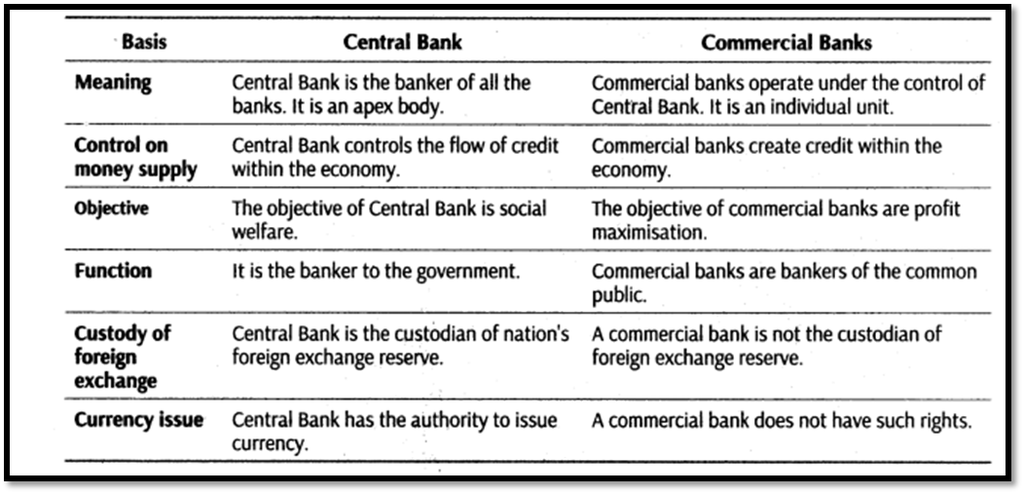
IMPORTANT TERMS FROM THE CHAPTER
- Commercial Bank: Commercial bank is a financial institution, which performs the functions of accepting deposits from the public and making loans and investments, with the motive of earning profit.
- Legal Reserve Ratio: It is the minimum ratio of deposits legally required to be kept by the commercial banks with themselves (Statutory Liquidity Ratio) and with the central bank, (Cash reserve Ratio).
- Money Multiplier or Credit Multiplier: When the primary cash deposit in the banking system leads to multiple expansion in the total deposits, it is known as money multiplier or credit multiplier.
- Central Bank: The central bank is the apex institution of a country’s monetary system. The design and the control of the country’s monetary policy is its main responsibility.
- Quantitative Instruments or General Tools of Monetary Policy: These are the instruments of monetary policy that affect overall supply of money/credit in the economy.
- Qualitative Instruments or Selective Tools of Monetary Policy: The instruments which are used to regulate the direction of credit is known as Qualitative Instruments.
- Bank rate: It is the rate of interest at which central bank lends to commercial banks without any collateral (security for purpose of loan).
- Repo rate: It is the rate at which commercial bank borrow money from the central bank for short period by selling their financial securities to the central bank.
- Reverse Repo rate: It is the rate at which the central bank (RBI) borrows money from commercial bank.
- Open Market Operation: It consists of buying and selling of government securities and bonds in the open market by central bank.
- Cash Reserve Ratio: It refers to the minimum percentage of a bank’s total deposits, which it is required to keep with the central bank.
- Statutory Liquidity Ratio: It refers to minimum percentage of net total demand and time liabilities, which commercial banks are required to maintain with themselves.
- Marginal requirement: Business and traders get credit from commercial bank against the security of their goods. Bank never gives credit equal to the full value of the security. It always pays less value than the security. Therefore, the difference between the value of security and value of loan is called marginal requirement.
- Moral suasion: It implies persuasion, request, informal suggestion, advice and appeal by the central banks to commercial banks to cooperate with general monetary policy of the central bank.
- Selective Credit Controls (SCCs): In this method, the central bank can give directions to the commercial banks not to give credit purposes or to give more credit for particular purposes or to the priority sectors.
AGGREGATE DEMAND
Aggregate Demand & Related concepts
AGGREGATE DEMAND
Definition: Aggregate demand refers to the total demand for final goods and services in an economy during an accounting year.
Aggregate demand is aggregate expenditure on ex-ante (planned) consumption and ex-ante (planned) investment that all sectors of the economy are willing to incur at each income level.

 Components of Aggregate Demand:
Components of Aggregate Demand:
Private (or Household) consumption demand
The total expenditure incurred by all the households of the country on their personal consumption is known as private consumption expenditure.
Consumption demand depends mainly on disposable income and propensity to consume.
Private investment demand
Private investment demand refers to the demand for capital goods by private investors.
It is addition to the existing stock of real capital assets such as machines, tools, factory – building etc.
Investments demand depends upon marginal efficiency of capital (Marginal efficiency of investment) and interest rate.
Investment is of two types, Autonomous Investment and Induced investment, but in Keynes theory investment is assumed to be Autonomous.
The basic difference between Induced Investment and Autonomous Investment
Government Expenditure
Government demand for goods and services. Its curve is upward sloping rises up to Right.
In a modern economy, the government is an important buyer of goods and services.
It is income inelastic, i.e., it is not affected by change in income level. The volume of autonomous investment is the same at all levels of income.
Its curve is a straight line parallel to horizontal axis.
The government demand may be because of public needs for roads, schools, hospitals, power, etc, for the maintenance of law and order and for defence.
Demand for net export (X – M)
Net export represents foreign demand for goods and services produced by an economy.
When exports exceed imports, net exports is positive and when imports exceed, net exports is negative.
Exports and imports of a country are influenced by a number of factors such as foreign trade policy, exchange- rate, prices and quality of goods etc.
Thus, aggregate demand consists of these four types of demand.
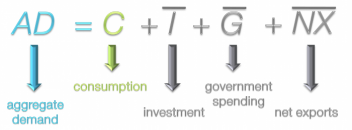
However, for the sake of simplicity Keynes included only two types of demand,
-> Consumption demand (C)
-> Investment demand (I)
Diagrammatic representation of AD
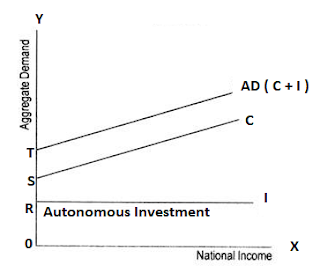
AGGREGATE DEMAND SCHEDULE
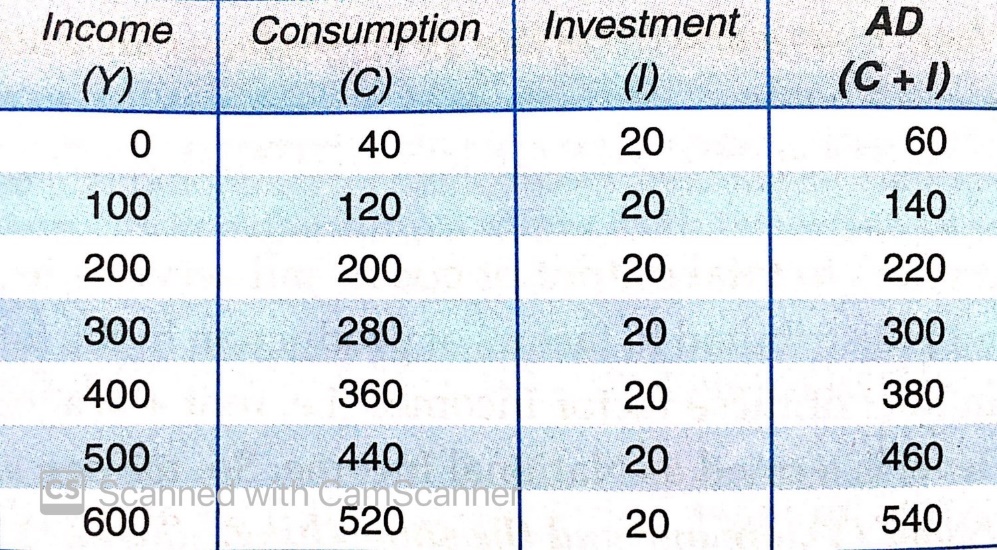
AGGREGATE SUPPLY
AGGREGATE SUPPLY
Definition: Aggregate supply refers to money value of final goods and services that all the producers are willing to supply in an economy in a given period.
The concept of aggregate supply (ΔS) is related with the total supply of goods and services by all the producers in an economy. Four factor of production like land, labour, capital and enterprise are required for the production of goods and services. Producers pay rent to land, wages and salaries to labour, interest to capital and Profits to the entrepreneur for their services in production. This payment is factor- cost from producer’s point of view and factor-income from factor-owner angle.
Thus, aggregate supply is the total amount of money value of goods and services, (which is paid to the factor of production against their factor services) that all the producers are willing to supply in an economy. In other words, it is the total cost of production of goods and services produced in a country or it is the value of net national product at factor cost (NNPFC). We can say Aggregate Supply (AS) = National Income (Y)
Keynes assumed his economy to be a closed capitalist economy and whenever any economy is closed capitalist, then Net Factor Income from Abroad (NFIA) is zero. National Income (NNPFC) = Domestic Income (NDPFC) + Net Factor Income from Abroad (NFIA)
National Income (NNPFC) = Domestic Income (NDPFC) + 0
In short,
Aggregate Supply = NNPFC = NDPFC = Factor Income = Rent + Interest + Wages + Profit
As we know income is either consumed or saved, hence for the sake of simplicity Keynes has regarded only two main constituents of aggregate supply:
NATIONAL INCOME (Y) = CONSUMPTION + SAVING
Y = AGGREGATE SUPPLY = CONSUMPTION + SAVING
Aggregate Supply Schedule and Diagrammatic Representation:
In the above figure, income is represented on the X-axis and consumption and saving are measured on the Y-axis. A 45-degree line, which represents the Aggregate Supply, has been drawn from the origin. At every point on this 45 degree line, Y = C + S.
CONSUMPTION FUNCTION
CONSUMPTION FUNCTION
Definition: Consumption function refers to that portion of income, which is spent on the purchase of goods and services at the given level of income.
Consumption function expresses functional relationship between aggregate consumption and national income.
Thus, consumption (C) is a function of income (Y). C = f(Y)
Where, C = Consumption; f = Functional relationship; Y = Disposable income Consumption at a point of time can be measured with the equation:
According to Keynes, as income increases consumption expenditure also increases but increase in consumption is smaller than the increase in income. In other words, consumption lags behind income. This is called Keynes’ Psychological law of Consumption. According to Keynes, propensity to consume of the people remains stable in the short period.
Break-even point refers to that point in the level of income at which consumption is just equal to income. In other words, whole of income is spent on consumption and there is no saving. Below this level of income, consumption is greater than income but above this level, income is greater than consumption.
Consumption Schedule
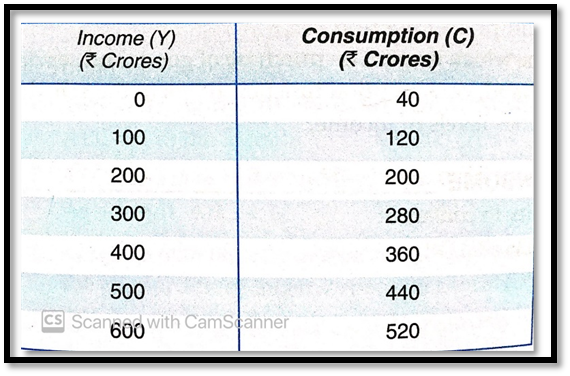
Consumption Curve
In the given imaginary household schedule of consumption, at annual income level of Rs.200 Crore, consumption is Rs.200 Crore and in consequence, there is no
saving. This is break-even point.
It is evident from the table and diagram that:
As the income increases, consumption also increases, but the increase in consumption remains less than the increase in income.
Income can be zero but consumption can never be zero in the economy.
When C > Y, saving are negative.
When C = Y, savings are zero. This is known as break-even point. This is shown by intersection of blue and red line in the diagram.
Thus, break-even point indicates a point where consumption becomes equal to income or consumption curve cuts the income curve.
TYPES OF PROPENSITIES TO CONSUME
TYPES OF PROPENSITIES TO CONSUME
Average Propensity of Consume
Marginal Propensity to Consume
Average propensity to consume (APC):
Definition: The ratio of aggregate consumption expenditure to aggregate income is known, as average propensity to consume.
It indicates the percentage (or ratio) of income which is being spent on consumption.
APC = Consumption (C) / Income (Y)
It can be explained with the help of following schedule and diagram:

Important Points for APC:
When APC is more than 1: When APC is more than 1, consumption is more than national income, i.e. before the break-even point.
APC = 1: When APC is equal to 1, consumption is equal to national income, which is known as to be break-even point.
When APC is less than 1: When consumption is less than national income, i.e. beyond the break-even point.
Marginal Propensity to consume (MPC):
Definition: The ratio of change in consumption (C) to change in income (Y) is known as marginal propensity to consume.
It indicates the proportion of additional income that is being spent on consumption.
MPC = Change in Consumption / Change in Income
It can be explained with the help of following schedule and diagram:
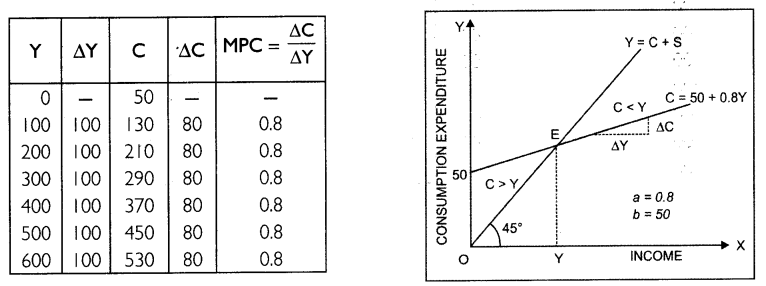
Important points for MPC:
Value of MPC varies between 0 and 1: As we know that increase in income is either spent on consumption or saved for future use.
MPC falls with the successive increase in income: It happens because as an economy becomes richer, it has the tendency to consume smaller percentage of each increment to its income.
DIFFERENCE BETWEEN APC & MPC
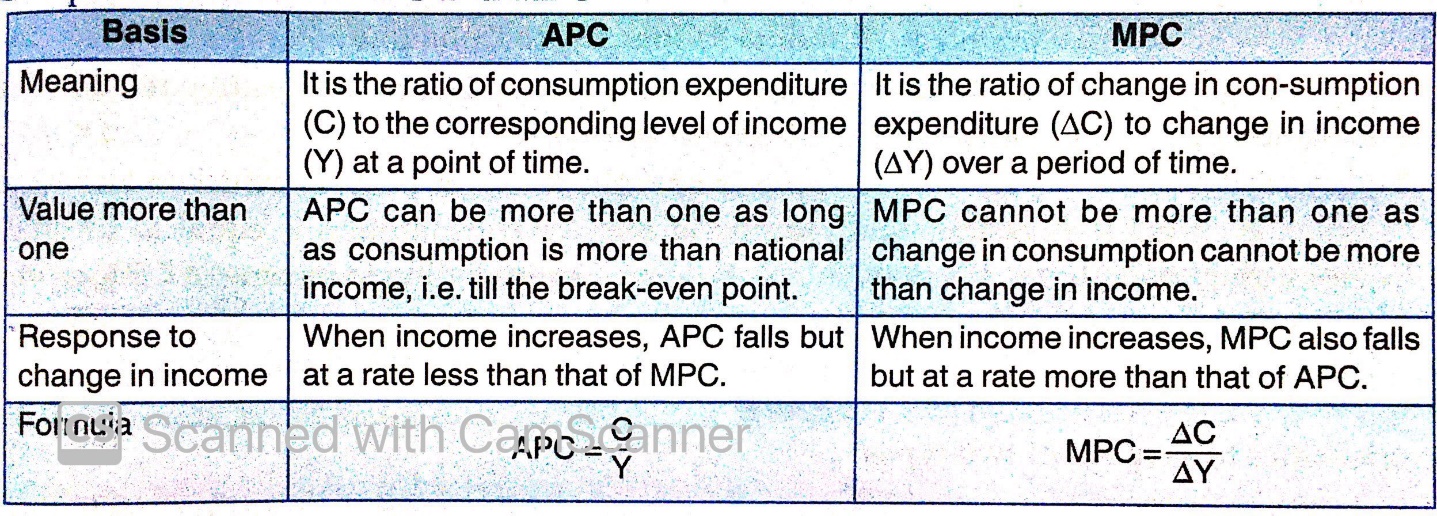
SAVING FUNCTION & NUMERICALS
SAVING FUNCTION (PROPENSITY TO SAVE)
Definition: Saving function refers to a functional relationship between saving and national income.
S= f(Y)
Where, S = Saving, Y = National Income, f = Functional relationship
Saving Schedule and Curve:
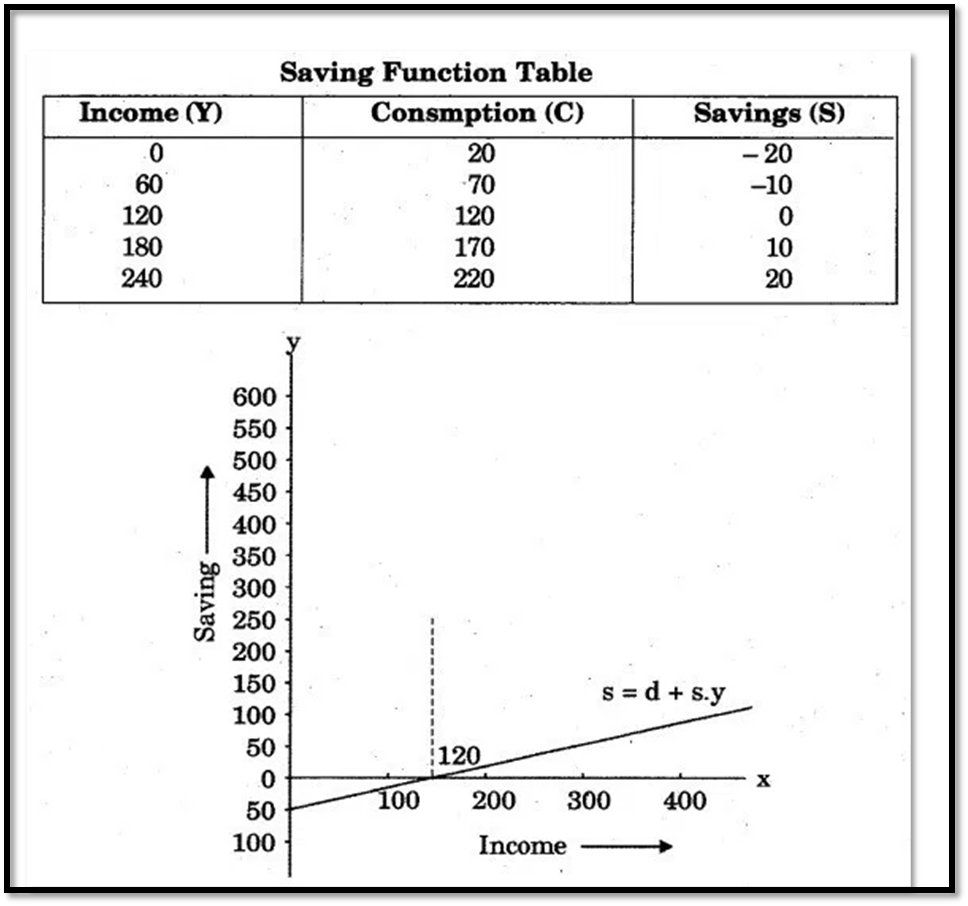
Saving curve (SS) starts from a below point on the Y-axis, indicating that there is negative saving (equal to amount of autonomous consumption) when national income is zero.
Note: The saving curve will have a negative intercept on Y-axis of the same magnitude as the consumption curve has positive intercept on the Y-axis. It happens because if consumption were positive at zero level of income, then there would be dis-savings of the same magnitude.
Break-even point (S = 0). Saving curve crosses the X-axis at point R which is known as break-even point as at this point saving is zero (or consumption is equal to income).
Positive Saving: After the break-even point, saving is positive.
TYPES OF PROPENSITIES TO SAVE
TYPES OF PROPENSITIES TO SAVE
Average Propensity to Save (APS)
Marginal Propensity to Save (MPS)
Average propensity to save (APS) :
Definition: The ratio of aggregate saving to aggregate income is known as average propensity to save (APS).
By dividing aggregate saving by aggregate income, we get APS.
APS = Saving (S) / Income (Y)
APS Schedule & Curve:
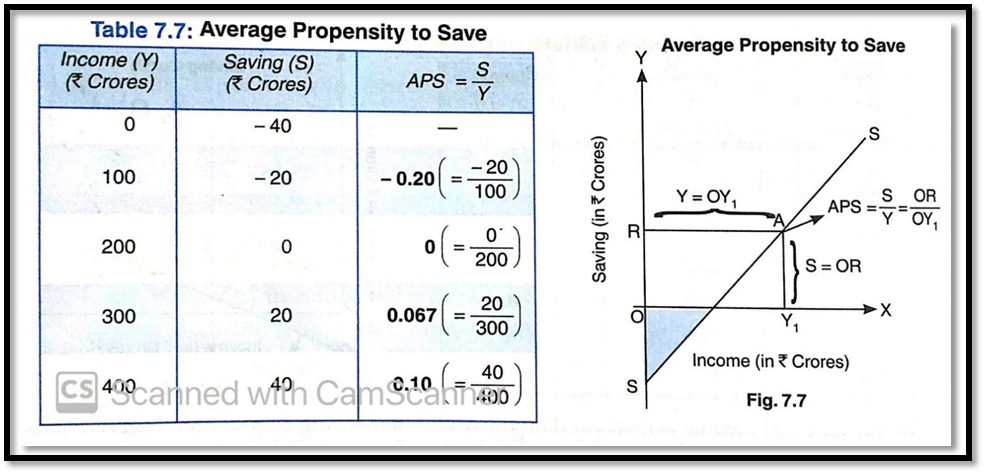
Important Points for APS:
APS can never be 1 or more than one. As saving, can never be equal to or more than national income.
APS can be 0: APS is 0 when income is equal to consumption i.e., saving = 0. This point is known as break-even point.
APS can be negative or less than 1. At income levels which are lower than the break-even point APS can be negative as there will be dis-savings in the economy.
APS rises with increase in income. APS rises with the increase in income because the proportion of income saved keeps on increasing.
Marginal Propensity to Save:
Definition: The ratio of change in saving (ΔS) to change in income (ΔY) is called MPS.
It is proportion of income saved out of additional (incremental) income.
MPC = Change in Saving / Change in Income
MPC Schedule & Curve:
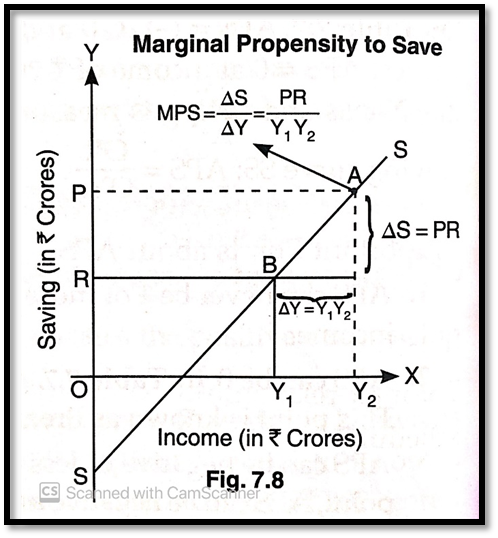
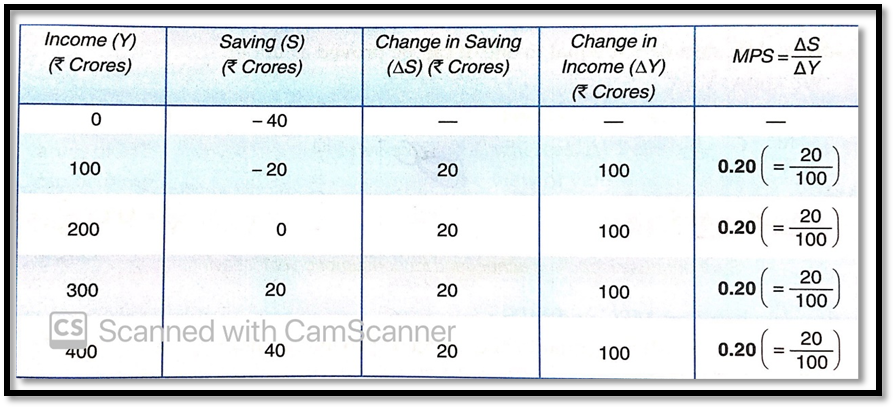
Important points for MPS:
Since MPS measures the slope of saving curve, constant value of MPS means that the saving curve is a straight line.
MPS varies between 0 and 1.If the entire additional income is saved then MPS = 1.
However, if the entire additional income is consumed, MPS = 0.
Comparison between APS & MPS.
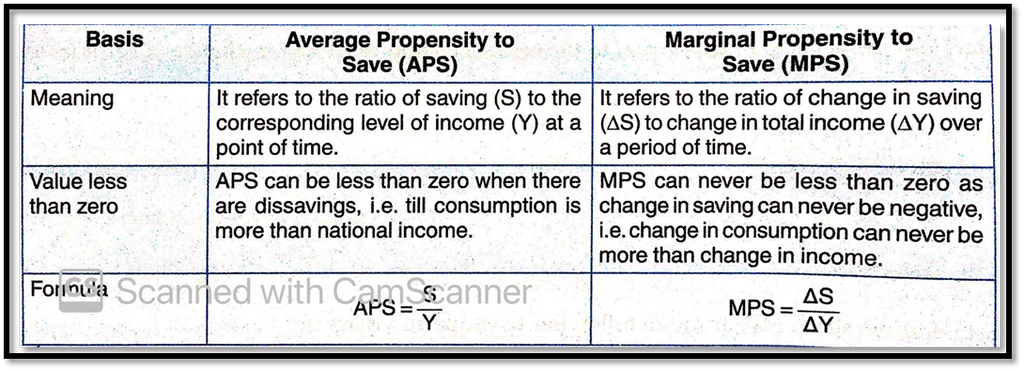
Relationship between APC & APS
Y = C+S
Dividing both sided by Y,
Y/Y = C/Y + S/Y
: 1 = APC + APS
Relationship between MPC & MPS
Change in Y = Change in C + Change in S
Dividing both side by Change in Y,
Change in Y/Change in Y = Change in C/Change in Y + Change is S/Change in Y
: 1 = MPC + MPS
DERIVATION OF SAVINGS CURVE FROM CONSUMPTION CURVE
EQUATION OF CONSUMPTION CURVE
Consumption curve can be put into two parts:
When income is zero, there is some consumption, which is known as autonomous consumption.
When income increases, consumption also increases but the rate of increase in income is more than that of increasing consumption and this rate depends upon MPC. The consumption pictures influenced by income is known as induced consumption, which can be estimated by multiplying MPC by income. i.e. b(Y)
Therefore, consumption can be represented as:
C= C̅+b(Y)
Where
C̅=Autonomous consumption
C= consumption,
b= MPC
Y= Income
EQUATION OF SAVING FUNCTION
With the help of linear consumption function situations, we can derive the equation of the linear saving function.
We know, Y=S+C
S=Y-C………………(1)
And C=C̅+b(Y)………….(2)
Putting the value of C in equation 1 we get.
S=Y-(C̅+b(Y))
S=Y-C̅-b(Y)
S= -C̅+Y-b(Y)
S=-C̅+Y(1-b)
Where,
S=savings
C̅=amount of dissaving’s at 0 levels of income.
Y= total income
1 – b = 1 – MPC = MPS
Derivation of Saving Curve from Consumption Curve
Let us understand how we derive the saving curve from the consumption curve:
At zero level of income, autonomous consumption is OC, which means that savings will be OS and hence saving curve will start from the point as on the negative y-axis.
Consumption curve intersects income curve at. Which means it is break-even point where consumption is equal to income, and savings are zero. Therefore, at this particular point saving curve will intersect the x-axis at point r. By joining points S and R and extending it further, we get the saving curve SS.
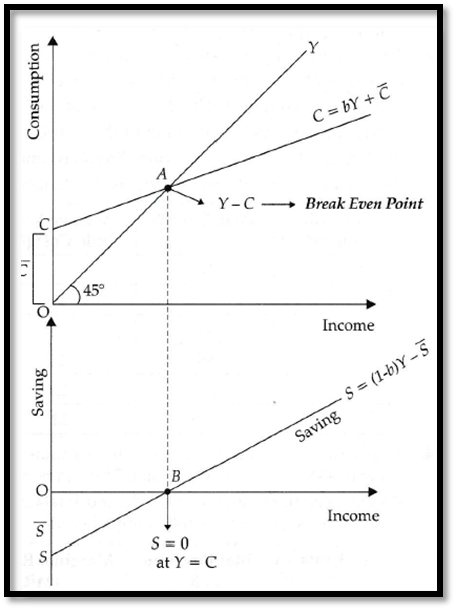
DERIVATION OF CONSUMPTION CURVE FROM SAVINGS CURVE
DERIVATION OF CONSUMPTION CURVE FROM SAVING CURVE
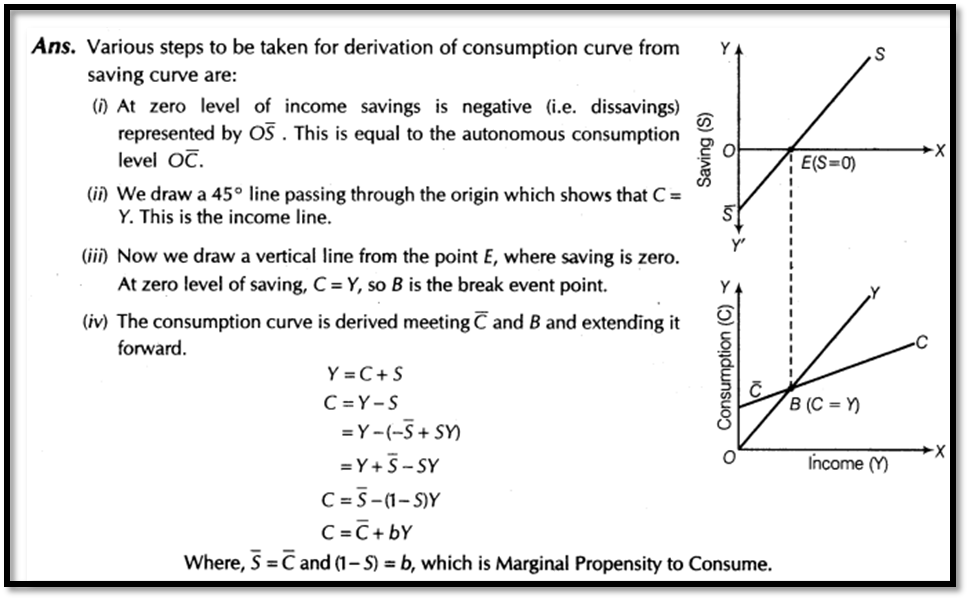
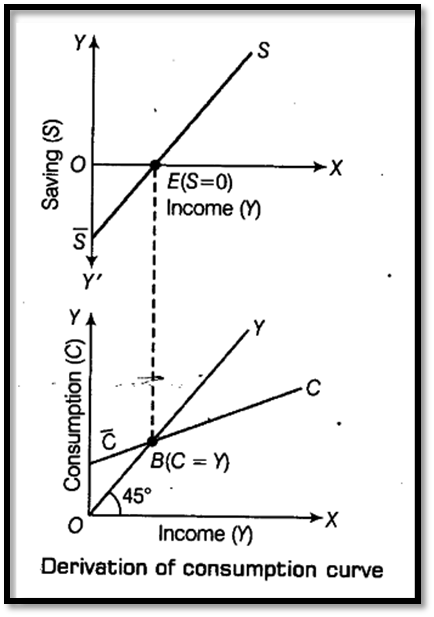
INVESTMENT FUNCTION
INVESTMENT FUNCTION
Definition: Investment refers to the expenditure incurred on the creation of New Capital Asset. For example, expenditure incurred on the purchase of machinery, building, equipment, etc.
It can be of two types:
(1) Induced investment
(2) Autonomous investment
Induced Investment
Definition: Induced investment is that investment, which is directly influenced by the level of income that is it, increases with income and it falls with a fall in income. These are made for profit Motive.
Autonomous Investment
Definition: Autonomous investment refers to investment, which is not influenced by the level of income. These are not made for-profit motive.
The government on infrastructure activities generally makes these types of investments.
The level of autonomous investment depends upon social, economic and political conditions of any country hence its take it changes when there is a change in technology on the discovery of new resources or growth of population, etc.
Difference between Induced Investment & Autonomous Investment.
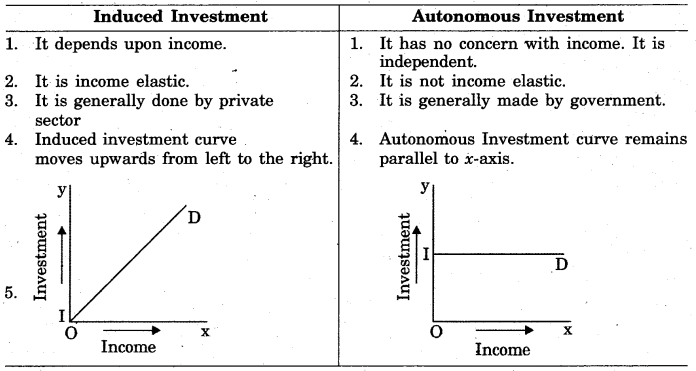
DETERMINANTS OF INVESTMENT
Investment in a new project depends upon two factors:
Marginal efficiency of investment
Rate of interest.
Marginal Efficiency of Investment:
Definition: Marginal efficiency of investment refers to the expected rate of return from additional investment.
It is determined by two factors:
Supply price: it happens to the cost of producing a new asset of that kind. It is the price at which the new capital can be supplied or replaced. for example, if a machine of rupees 1100000 is replaced in place of an old machine, then Rupees 1 lakh is supplied price
Protective yield: it refers to net return expected from the Capital Asset over its lifetime. For example, if the expected yield from a machine is rupees 8000 and running expenses are rupees 500 then protective Shield could be rupees 8000 - 500 is equal to Rs 7500.
In the above example, MEI will be calculated as follows:
MEI = Protective yield / Supply price * 100
MEI = 7500/100000 = 7.5%
Rate of Interest:
It refers to the cost of borrowing money for financing Investments. There exist an inverse relationship between ROI and volume of investment. At a higher ROI, investment soending will be less and vice-versa.
COMAPARISON OF MEI & ROI:
Profitability of an investment can be worked out by comparing MEI with ROI. IF MEI >ROI, investment is profitable as at this point, return from investment is more as compared to cost and if MEI<ROI, investment is not profitable as at this point return from investment is less as compared to cost.
SAVINGS & INVESTMENT
INVESTMENT
Investment or capital formation refers to addition to the capital stock of an economy. For example-Construction of roads, flyovers, Building, etc.
Investment can be of two forms:
- Gross Investment
- Definition: It is an addition to the stock of capital before making allowance for depreciation
- Net Investment
- Definition: Net Investment is an actual addition made to the capital stock of the economy in a given period.
Net Investment = Gross Investment- Depreciation
EX-ANTE & EX-POST SAVING AND INVESTMENT
Definition: Ex-ante means planned or expected value of the variable, whereas Ex-post means an actual or realized value of the variable.
Both are generally used in the context of saving and investment. There are two aspects of Savings and Investments:
- Ex Ante saving and Ex Ante investments
- Ex-post saving and Ex post investments
Ex-Ante Savings
Refers to the amount, which households are planning to save at different level of income in the economy.
Ex-Ante Investments
It refers to the amount of investment, which firms plan to invest at a different level of income in the economy.
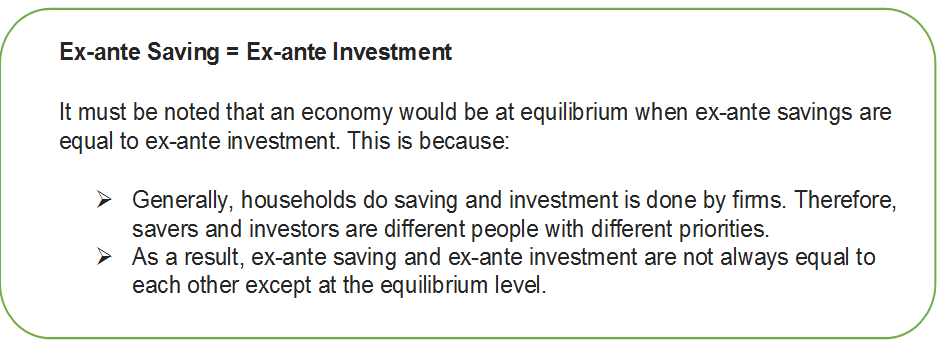
EX-POST SAVINGS
Ex-post saving refers to actually organized saving in an economy during the year.
EX-POST INVESTMENTS
It refers to actual or realized investment in an economy during a year.
FULL EMPLOYMENT
FULL EMPLOYMENT
Definition: Full employment refers to a situation in which all those people who are willing and able to work at the existing wage rate get work without any due difficulty. Ordinarily, the term full employment refers to the situation in which no one is employed.
Under full employment, there can be two types of unemployment:
Frictional unemployment: Sometimes people leave one job in search for some other job and remain vacant between these periods; this is termed as frictional unemployment.
Structural unemployment: Where people remain unemployed due to a mismatch between unemployed person and demand for a specific type of workers. For example, due to the introduction of new technology, the old staff become unemployed as now they do not possess enough exercise to do a particular job.
UNEMPLOYMENT
INVOLUNTARY UNEMPLOYMENT
Definition: It refers to an unemployment in which all those people, who are willing and able to work at the existing wage rate, do not get work.
It must be noted that only involuntary unemployment is considered while estimating the total unemployment in an economy.
VOLUNTARY UNEMPLOYMENT
Voluntary unemployment refers to a situation when a person is unemployed because he/she is not willing to work at the existing wage rate.
Voluntary unemployment is not counted while estimating the size of unemployment.
EQUILIBRIUM LEVEL
EQUILIBRIUM LEVEL
According to Keynes Theory, an economy is in equilibrium when aggregate demand of goods and services is equal to aggregate supply during a period of time.
Equilibrium is achieved when,
AD=AS (1)
Since,
AD= C + I
AS = C + S
: C + I = C + S
Or S = I
The two approaches for equilibrium are-
1. AD-AS approach.
2. S-I approach
Before proceeding, we will make the following assumption for better understanding:-
Only two-sector exists in an economy (households and firms). There is no government & foreign sector.
It is assumed that Investment is autonomous i.e. it is not influenced by the level of income.
Price level is assumed to be constant.
Equilibrium output is to be determined in the context of short-run.
AGGREGATE DEMAND AND AGGREGATE SUPPLY APPROACH (AD-AS Approach)
According to Keynesian Theory, the equilibrium level of income in an economy is determined when aggregate demand, represented by C+I curve is equal to the total output (Aggregate Supply or AS).
Aggregate Demand Comprises of Two components:-
Consumption Expenditure (C):- It varies directly with the level of income i.e. consumption rises with the increase in income.
Investment Expenditure (I):- It is assumed to be independent of the level of income i.e. investment expenditure is autonomous.
Aggregate Supply is the total output of goods and services of the national income, since income is either consumed or saved, the AS curve is represented by the (C+S) curve.
Equilibrium by AD and AS approach
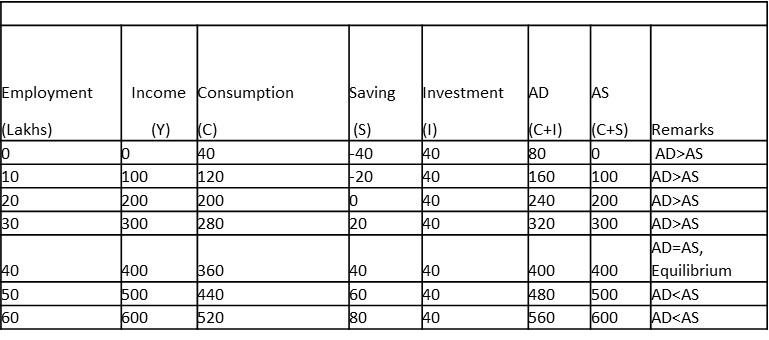
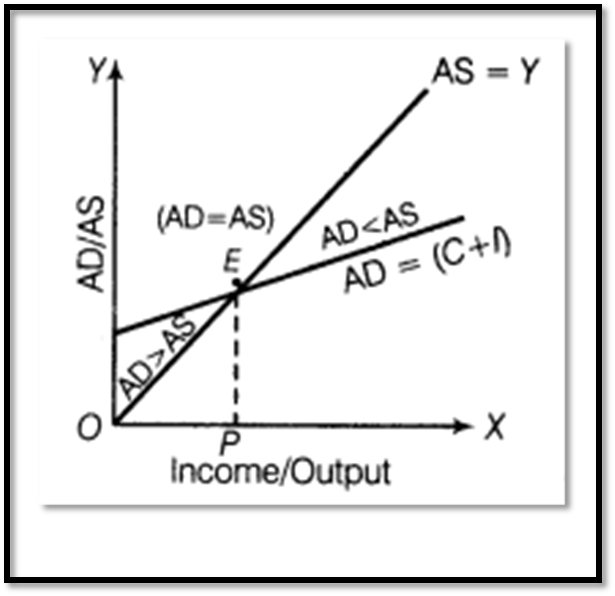
Observation from the above Schedule and Diagram
Investment Curve -(I) is parallel to X-axis as it is autonomous and does not depends upon the level of income whereas saving curve(S) is upward sloping as saving increase with rising in Income. The Economy would be in equilibrium at point E where saving and investment intersect each other. At this level planned savings are equal to planned investments.
When savings are more than Investments -If planned savings are more than planned investment, i.e. after point E, a household is not consuming as much as firms expected them to as a result, the inventory would rise above the desired level.
When savings are less than investments- If planned savings are less than Investments, i.e. before point E, a household is consuming more, and savings less than what firms expected them to as a result planned inventory would fall below the desired level.
The economy is in equilibrium at point E where AD=AS.
E is the equilibrium point because, at this point, the level of the desired spending on consumption and investment exactly equals the level of total output.
OY is the equilibrium level of output corresponding to point E.
The equilibrium level of income is rupees 400 crores, where AD=AS
It is a situation of effective demand. Effective demand refers to that level of AD, which become effective because it is equal to AS.
When AD is more than AS
When planned spending is more than planned output (AS) it means that people are ready to spend more and firms are willing to produce less as a result planned inventory would fall below the desired level.
When AD is less than AS
When planned to spend a less than planned output it means that people are not ready to spend more and firms are willing to produce more as a result planned inventory would rise above the desired level.
SAVING – INVESTMENT APPROACH (S-I Approach)
According to S-I approach equilibrium level is determined at a point where planned savings are equal to planned Investments.
Schedule & Diagram:
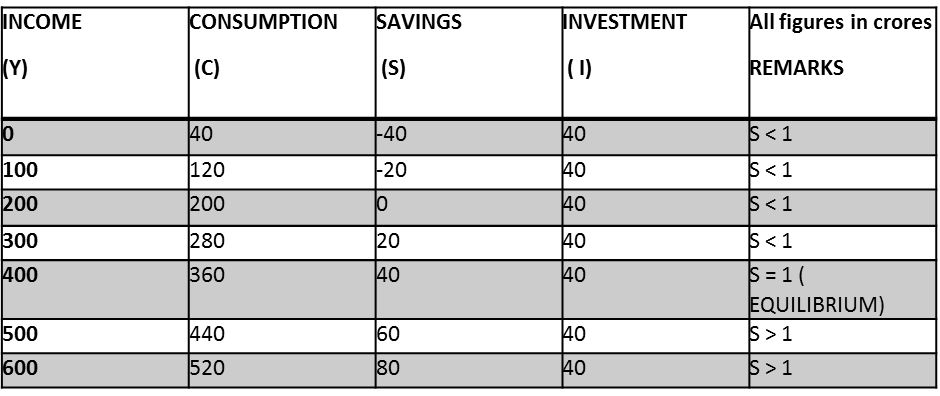

Investment Curve is parallel to the x-axis as it is autonomous and does not depends upon the level of income. Whereas the saving curve is upward sloping as savings increases with rising in income .the economy would. Be in equilibrium at point E where saving and investment intersect each other. At this level, planned savings are equal to planned investment.
When savings are more than investment
If planned savings are more than planned investment that is after. Point E houses are not consuming as much as firms expected them to. As a result, the inventory would rise above the desired level.
When savings are less than Investments.
If plant savings are less than investment before Point E households are consuming more and saving less than what firms expected them to. As a result, planned inventory would fall below the desired level.
Equilibrium Level
According to the classical economics equilibrium level of income is attained always at full employment level i.e. there is the absence of involuntary unemployment. However, as per the Keynesian Theory of Equilibrium level can be achieved at-
1. Full Employment Level or
2. Under Employment Level i.e. less than full employment level or
3. Over Employment Level i.e. more than full employment level.
Full Employment Equilibrium
It refers to a situation when equality between AD and AS takes place at the full employment level of income.
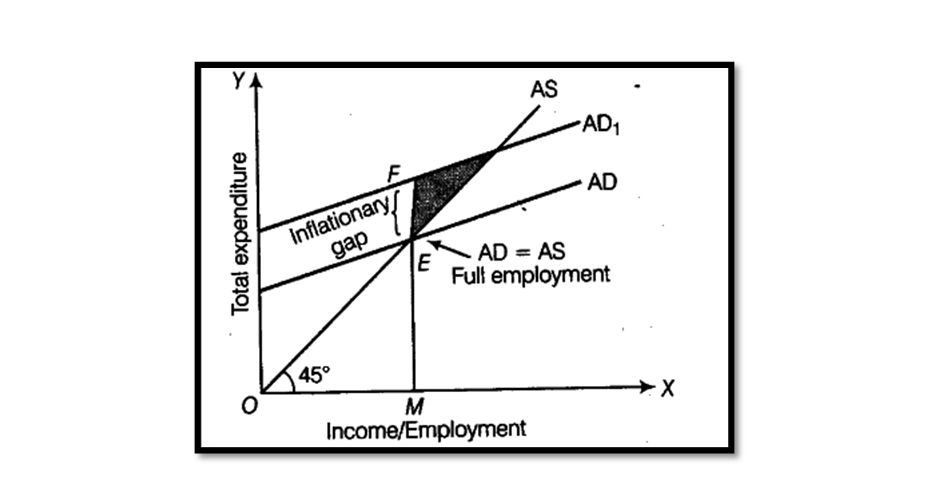
In the given figure, Full Employment equilibrium is achieved at Point ‘E’ where EM is equal to OM. At this particular point, there is no involuntary unemployment i.e. those who are willing and able to work are getting it at a prevailing wage rate.
Under Employment Equilibrium
It refers to a situation when aggregate demand is equal to aggregate supply beyond the full employment level.
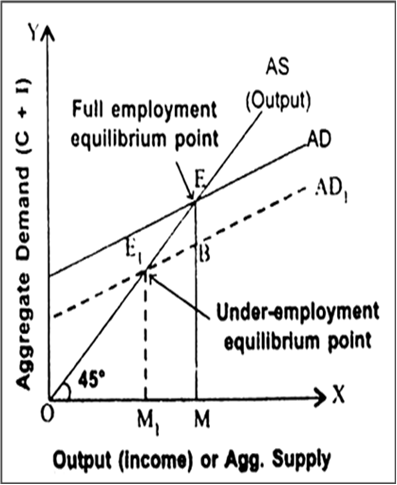
Here, AD = AS at Point E1 which is lower than full employment level. As OM1 is less than OM, Point ‘E1’ signifies the underemployment equilibrium.
Over full Employment Equilibrium
It refers to a situation when the equilibrium between AD & AS takes place at more than full Employment Level.
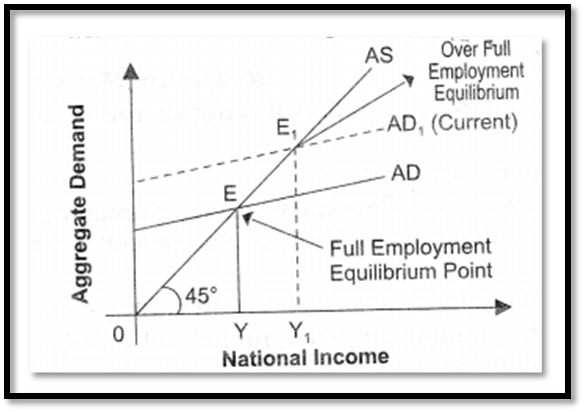
Here, AD, = AS at point E1 which is higher than the full employment level. Point E1 signifies the over full-employment equilibrium.
INVESTMENT MULTIPLIER
INVESTMENT MULTIPLIER
Keynes believed that an initial increment in investment increases the final income by many times. Multiplier (K) is the ratio of increase in national income (Y) due to an increase in investment (I).
Symbolically, K = Y / I
Multiplier and MPC
There exist a direct relationship between MPC and the value of the multiplier, higher the MPC, more will be the value of the multiplier, and vice-versa. The reason for this is:
In the case of higher MPC, people will spend a large proportion of their income on consumption. In such case, the value of multiplier will be more.
In case of low MPC, people will spend lesser proportion of their increased income on consumption. In such case, value of multiplier will be comparatively less.
Algebraically, since, Y = C + I
Therefore change in Y = change in C + change in I
Dividing both sides by Y
Y/Y = C/Y + I/Y
1 = MPC + I/K (: Y/Y = 1, C/Y = MPC, I/Y = I/K)
1 – MPC = I/K
K= I /1-MPC or I / PC (: I - MC = MPS)
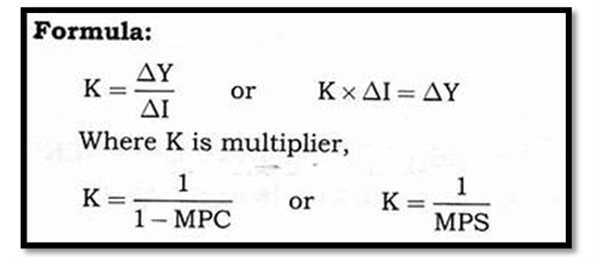
Multiplier is directly related to MPC and inversely related to MPS
The above statement can be easily proved through the following table:-

It is clearly seen in the above table that as MPC is increasing, Multiplier is also increasing which shows positive relationship whereas it is increase with fall in MPS, which shows negative relationship.
The maximum value of the multiplier can be infinity when MPC is I and MPS is Zero whereas the minimum value of the multiplier can be I when MPC is 0 and MPS is 1.
Working of Multiplier
The working of multiplier is based on fact that ‘One person’s expenditure is another person’s income’. When an additional investment is made, then income increased many times more than the increase in investment. Let us understand this with the help of an example:-
- Suppose the government for some infrastructural activities makes an additional investment of Rs.1000 crores. This will generate an extra income of Rs.1000 crores in the first round. However, this is not the end of the story.
- If MPC is assumed to be 0.80, then the recipient of this additional income will spend 80% of Rs.1000 crore i.e. Rs 8000 crore as consumption and remaining amount will be saved. It will increase the income by Rs. 800 Crore in second round.
- In next round, 90% of additional income of Rs.8000 crore i.e. Rs. 640 crore will be spent on consumption and the remaining amount will be saved.
- This multiplier process will go on and consumption in every round will be 0.80 times of additional income received from the previous round.
- Here value of Multiplier(K) =Y/I = 5000/1000=5 times Or I/MPS (I/I-MPC) =1/0.20 = 5 times
- Therefore, an initial increase in investment by one unit will increase total national income by 5 times.
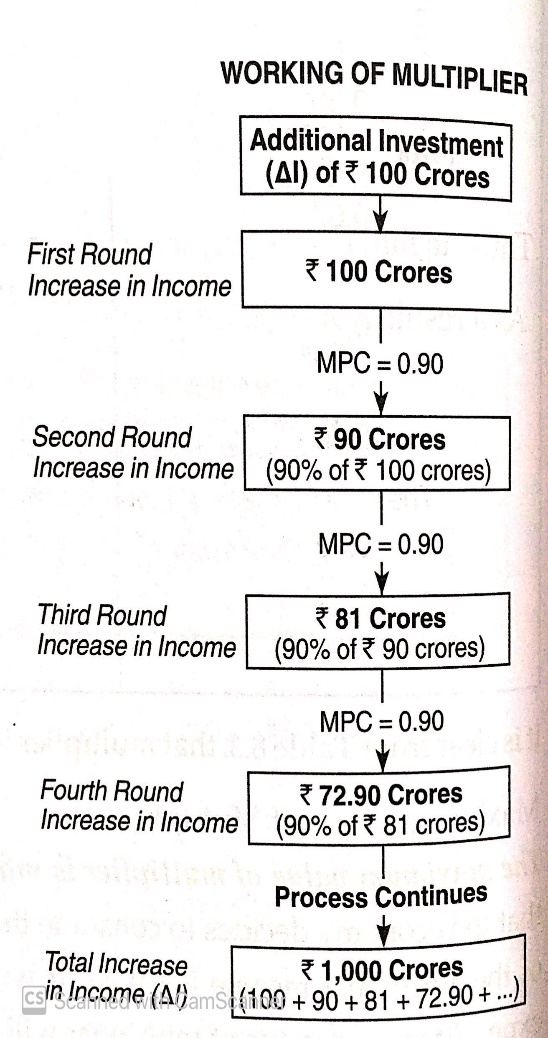
Diagrammatic presentation of Multiplier:
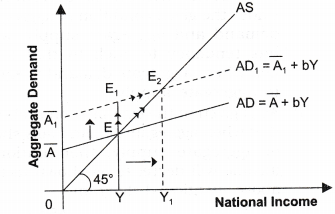
EXCESS DEMAND
Excess Demand
Definition: Excess Demand refers to a situation when aggregate demand is more than the aggregate supply corresponding to full employment level of output in the economy.
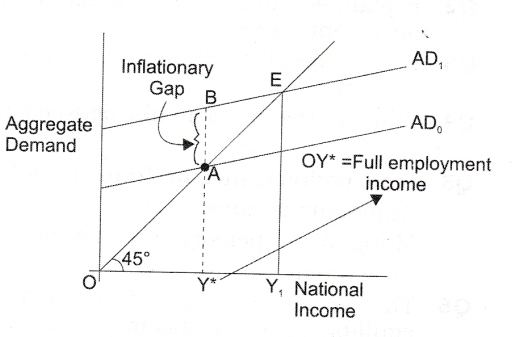
Inflationary gap is the gap showing excess of current aggregate demand over ‘aggregate supply at the level of full employment’. It is called inflationary because it leads to inflation (continuous rise in prices).
Here is a simple example, let us suppose that an imaginary economy by employing all its available resources can produce 10,000 quintals of rice. If aggregate demand of rice is say 12,000 quintals, this demand will be called an excess demand, because aggregate supply at level of full employment of resources is only 10,000 quintals and the result of the gap of 2000 quintals will be called as inflationary gap. In the above diagram Inflationary gap is AB because at Full employment (Y*), Aggregate demand (BY*) is greater than Aggregate Supply (AY*).
Reasons for Excess Demand:
Increase in household consumption demand due to rise in propensity to consume.
Increase in private investment demand because of rise in credit facilities.
Increase in public (government) expenditure.
Increase in export demand.
Increase in money supply or increase in disposable income.
Impacts of Excess Demand on Price, Output & Employment:
Effect on General Price Level: Excess demand gives a rise to general price level because it arises when aggregate demand is more than aggregate supply at a full employment level. There is inflation in economy showing inflationary gap.
Effect on Output: Excess demand has no effect on the level of output. Economy is at full employment level and there is no idle capacity in the economy. Hence, output cannot increase.
Effect on Employment: There will be no change in the level of employment also.
The economy is already operating at full employment equilibrium, and hence, there is no unemployment.
Deficient Demand:
Definition: When in an economy, aggregate demand falls short of aggregate supply at full employment level, the demand is said to be a deficient demand.
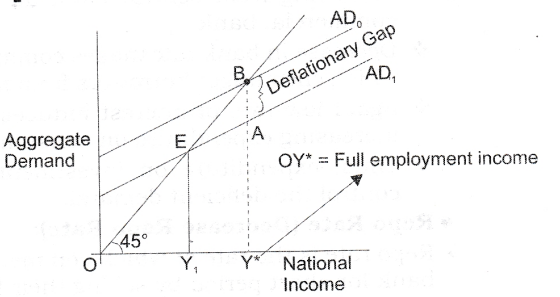
Deflationary gap is the gap showing Demand deficient of current aggregate demand over ‘aggregate supply at the level of full employment’. It is called deflationary because it leads to deflation (continuous fall in prices).
Let us suppose that an imaginary economy by employing all its available resources can produce 10,000 quintals of rice. If aggregate demand of rice is, say 8,000 quintals, this demand will be called a deficient demand and the gap of 2000 quintals will be called as deflationary gap. Clearly here, equilibrium between AD and AS is at a point less than level of full employment. Keynes called it an under employment equilibrium.
Reasons for Deficient Demand:
Decrease in household consumption demand due to fall in propensity to consume.
Decrease in private investment demand because of fall in credit facilities.
Decrease in public (government) expenditure.
Decrease in export demand.
Decrease in money supply or decrease in disposable income.
Impacts or effects of deficient demand:
Effect on General Price Level: Deficient demand causes the general price level to fall because it arises when aggregate demand is less than aggregate supply at full employment level. There is deflation in an economy showing deflationary gap.
Effect on Employment: Due to deficient demand, investment level is reduced, which causes involuntary unemployment in the economy due to fall in the planned output.
Effect on Output: Low level of investment and employment implies low level of output.
DIFFERENCE BETWEEN EXCESS DEMAND & DEFICIENT DEMAND:
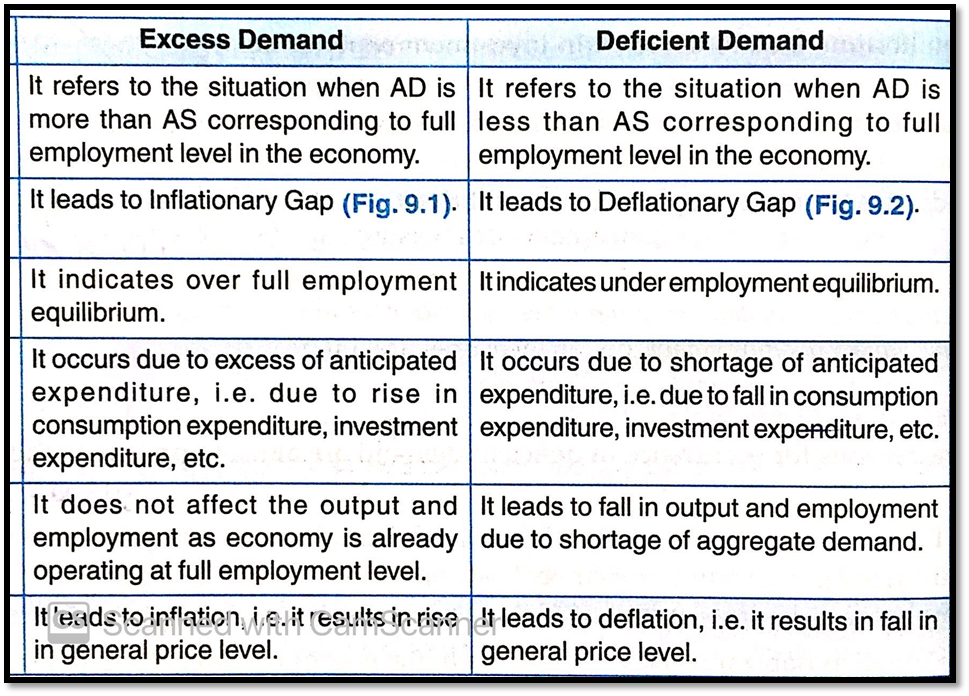
DEFICIENT DEMAND
Deficient Demand:
Definition: When in an economy, aggregate demand falls short of aggregate supply at full employment level, the demand is said to be a deficient demand.
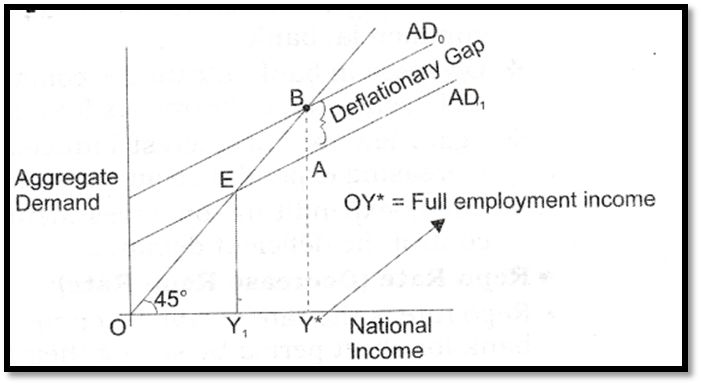
- Deflationary gap is the gap showing Demand deficient of current aggregate demand over ‘aggregate supply at the level of full employment’. It is called deflationary because it leads to deflation (continuous fall in prices).
- Let us suppose that an imaginary economy by employing all its available resources can produce 10,000 quintals of rice. If aggregate demand of rice is, say 8,000 quintals, this demand will be called a deficient demand and the gap of 2000 quintals will be called as deflationary gap. Clearly here, equilibrium between AD and AS is at a point less than level of full employment. Keynes called it an under employment equilibrium.
Reasons for Deficient Demand:
- Decrease in household consumption demand due to fall in propensity to consume.
- Decrease in private investment demand because of fall in credit facilities.
- Decrease in public (government) expenditure.
- Decrease in export demand.
- Decrease in money supply or decrease in disposable income.
Impacts or effects of deficient demand:
- Effect on General Price Level: Deficient demand causes the general price level to fall because it arises when aggregate demand is less than aggregate supply at full employment level. There is deflation in an economy showing deflationary gap.
- Effect on Employment: Due to deficient demand, investment level is reduced, which causes involuntary unemployment in the economy due to fall in the planned output.
- Effect on Output: Low level of investment and employment implies low level of output.
DIFFERENCE BETWEEN EXCESS DEMAND & DEFICIENT DEMAND:
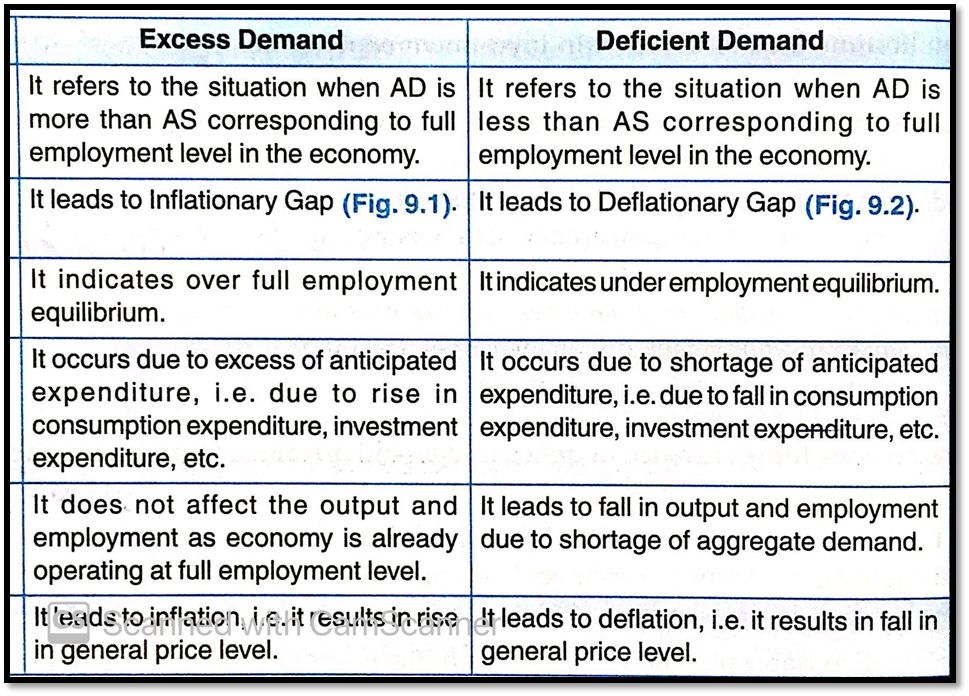
MEASURES TO CONTROL AD - MONETARY POLICY & FISCAL POLICY
MEASURES TO CONTROL EXCESS DEMAND
We can control the excess demand with the help of the following policy:
(1) Monetary Policy
(2) Fiscal Policy
(a) Monetary Policy: Monetary policy is the policy of the central bank of a county to control money supply and availability of credit in the economy. The central bank can take the following steps:
1. Quantitative Instruments or General Tools of Monetary Policy: These are the instruments of monetary policy that affect overall supply of money/credit in the economy. These instruments do not direct or restrict the flow of credit to some specific sectors of the economy. They are as under:
Bank Rate or Discount Rate (Increase in Bank Rate)
Bank rate is the rate of interest at which central bank lends to commercial banks without any collateral (security for purpose of loan). The thing, which has to be remembered, is that central bank lends to commercial banks and not to public.
In a situation of excess demand leading to inflation.
Central bank raises bank rate that discourages commercial banks in borrowing from central bank, as it will increase the cost of borrowing of commercial bank.
It forces the commercial banks to increase their lending rates, which discourages borrowers from taking loans, which discourages investment.
Again high rate of interest induces households to increase their savings by restricting expenditure on consumption.
Thus, expenditure on investment and consumption is reduced, which will control the excess demand.
Repo Rate (Increase in Repo Rate):
Repo rate is the rate at which commercial banks borrow money from the central bank for short period by selling their financial securities to the central bank.
These securities are pledged as a security for the loans.
It is called Repurchase rate as this involves commercial bank selling securities to RBI to borrow the money with an agreement to repurchase them at a later date and at a predetermined price.
Therefore, keeping securities and borrowing is repo rate.
In a situation of excess demand leading to inflation, Central bank raises repo rate that discourages commercial banks in borrowing from central bank, as it will increase the cost of borrowing of commercial bank.
It forces the commercial banks to increase their lending rates, which discourages borrowers from taking loans, which discourages investment.
Again high rate of interest induces households to increase their savings by restricting expenditure on consumption.
Thus, expenditure on investment and consumption is reduced, which will control the excess demand.
Reverse Repo Rate (Increase in Reverse Repo Rate):
It is the rate at which the central bank (RBI) borrows money from commercial bank.
In a situation of excess demand leading to inflation, Reverse repo rate is increased, it encourages the commercial bank to park their funds with the central bank to earn higher return on idle cash. It decreases the lending capability of commercial banks, which controls excess demand.
Open Market Operations (OMO) (Sale of securities):
It consists of buying and selling of government securities and bonds in the open market by central bank.
In a situation of excess demand leading to inflation, central bank sells government securities and bonds to commercial bank. With the sale of these securities, the power of commercial bank of giving loans decreases, which will control excess demand.
Increase in Varying Reserve Requirements or Legal Reserve Ratio:
Banks are obliged to maintain reserves with the central bank, which is known as legal reserve ratio. It has two components. One is the Cash Reserve Ratio or CRR and the other is the SLR or Statutory Liquidity Ratio.
Cash Reserve Ratio (Increase in CRR):
It refers to the minimum percentage of a bank’s total deposits, which
it is required to keep with the central bank. Commercial banks have to keep with the central bank a certain percentage of their deposits in the form of cash reserves as a matter of law.
For example, if the minimum reserve ratio is 10% and total deposits of a certain bank is Rs.100 crore, it will have to keep Rs.10 crore with the central bank.
In a situation of excess demand leading to inflation, cash reserve ratio (CRR) is raised to 20 percent. The bank will have to keep Rs.20 crore with the central bank, which will reduce the cash resources of commercial bank and reducing credit availability in the economy, which will control excess demand.
Statutory Liquidity Ratio (Increase SLR):
It refers to minimum percentage of net total demand and time liabilities, which commercial banks are required to maintain with themselves.
In a situation of excess demand leading to inflation, the central bank increases statutory liquidity ratio (SLR), which will reduce the cash resources of commercial bank and reducing credit availability in the economy.
2. Qualitative Instruments or Selective Tools of Monetary Policy:
These instruments are used to regulate the direction of credit. They are as under:
Imposing margin requirement on secured loans (Increase):
Business and traders get credit from commercial bank against the security of their goods. Bank never gives credit equal to the full value of the security. It always pays less value than the security.
Therefore, the difference between the value of security and value of loan is called marginal requirement.
In a situation of excess demand leading to inflation, central bank raises marginal requirements. This discourages borrowing because it makes people get less credit against their securities.
Moral Suasion:
Moral suasion implies persuasion, request, informal suggestion, advice and appeal by the central banks to commercial banks to cooperate with general monetary policy of the central bank.
In a situation of excess demand leading to inflation, it appeals for credit contraction.
Selective Credit Control (SCC) [Introduce Credit Rationing]:
In this method, the central bank can give directions to the commercial banks not to give credit for certain purposes or to give more credit for particular purposes or to the priority sectors.
In a situation of excess demand leading to inflation, the central bank introduces rationing of credit in order to prevent excessive flow of credit, particularly for speculative activities. It helps to wipe off the excess demand.
(b) Fiscal Policy: The expenditure and revenue policy taken by the general government to accomplish the desired goals is known as fiscal policy. A general government can take the following steps:
Revenue Policy (Increase Taxes):
Revenue policy is expressed in terms of taxes.
During inflation the government impose higher amount of taxes causing the decrease in purchasing power of the people.
It is so because to control excess demand we have to reduce the amount of liquidity from the economy.
Expenditure Policy (Reduces Expenditure):
Government has to invest huge amount on public works like roads, buildings, irrigation works, etc.
During inflation, government should curtail (reduce) its expenditure on public works like roads, buildings, irrigation works thereby reducing the money income of the people and their demand for goods and services.
Increase in Public Borrowing/Public Debt:
This measure means that government should raise loans from public and hence borrowing decreases the purchasing power of people by leaving them with lesser amount of money.
Therefore, government should resort to more public borrowing during excessive demand.
Government should make long term debts more attractive so that public may use their excess liquidity amount of money in purchasing these bonds, which will reduce the liquidity amount of money in the economy and thereby inflation could be controlled
Measures to Control the deficient demand:
We can control the deficient demand with the help of the following policies:
(a) Monetary policy
(b) Fiscal policy
Monetary Policy: Monetary policy is the policy of the central bank of a country of controlling money supply and availability of credit in the economy. The central bank takes the following steps:
1. Quantitative Instruments or General Tools of Monetary Policy: These are the instruments of monetary policy that affect overall supply of money/credit in the economy. These instruments do not direct or restrict the flow of credit to some specific sectors of the economy. They are as under:
Bank Rate or Discount Rate (Decrease in Bank Rate):
Bank rate is the rate of interest at which central bank lends to commercial banks without any collateral (security for purpose of loan). The thing, which has to be remembered, is that central bank lends to commercial banks and not to public.
In a situation of deficient demand leading to deflation, Central bank decreases bank rate that encourages commercial banks in borrowing from central bank as it will decrease the cost of borrowing of commercial bank.
Decrease in bank rate makes commercial bank to decrease their lending rates, which encourages borrowers from taking loans, which encourages investment.
Again low rate of interest induces households to decrease their savings by increasing expenditure on consumption.
Thus, expenditure on investment and consumption increase, which will control the deficient demand.
Repo Rate (Decrease Repo Rate):
Repo rate is the rate at which commercial banks borrow money from the central bank for short period by selling their financial securities to the central bank.
These securities are pledged as a security for the loans.
It is called Repurchase rate as this involves commercial bank selling securities to RBI to borrow the money with an agreement to repurchase them at a later date and at a predetermined price.
Therefore, keeping securities and borrowing is repo rate.
In a situation of deficient demand leading to deflation, Central bank decreases Repo rate that encourages commercial banks in borrowing from central bank, as it will decrease the cost of borrowing of commercial bank.
Decrease in Repo rate makes commercial banks to decrease their lending rates, which encourages borrowers from taking loans, which encourages investment.
Again low rate of interest induces households to decrease their savings by increasing expenditure on consumption.
Thus, expenditure on investment and consumption increase, which will control the deficient demand.
Reverse Repo Rate (Decrease Reverse Repo Rate):
It is the rate at which the central bank (RBI) borrows money from commercial bank.
In a situation of deficient demand leading to deflation, Reverse repo rate is decreased, it discourages the commercial bank to park their funds with the central bank. It increases the lending capability of commercial banks, which controls deficient demand.
Open Market Operation (Purchase of Securities):
It consists of buying and selling of government securities and bonds in the open market by central bank.
In a situation of deficient demand leading to deflation, central bank purchases government securities and bonds from commercial bank. With the purchase of these securities, the power of commercial bank of giving loans increases, which will control deficient demand.
Decrease in Varying Reserve Requirements:
Banks are obliged to maintain reserves with the central bank, which is known as legal reserve ratio. It has two components. One is the Cash Reserve Ratio or CRR and the other is the SLR or Statutory Liquidity Ratio.
Cash Reserve Ratio (Decrease):
It refers to the minimum percentage of a bank’s total deposits, which is required to keep with the central bank. Commercial banks have to keep with the central bank a certain percentage of their deposits in the form of cash reserves as a matter of law.
For example, if the minimum reserve ratio is 10% and total deposits of a certain bank is Rs. 100 crore, it will have to keep Rs.10 crore with the central bank.
In a situation of deficient demand leading to deflation, cash reserve ratio (CRR) falls to 5 percent, the bank will have to keep Rs. 5 crore with the central bank, which will increase the cash resources of commercial bank and increasing credit availability in the economy, which will control deficient demand.
The Statutory Liquidity Ratio (SLR) (Increase):
It refers to minimum percentage of net total demand and time liabilities, which commercial banks are required to maintain with themselves.
In a situation of deficient demand leading to deflation, the central bank decreases statutory liquidity ratio (SLR), which will increase the cash resources of commercial bank and increases credit availability in the economy.
2. Qualitative Instruments or Selective Tools of Monetary Policy: These
instruments are used to regulate the direction of credit. They are as under:
Imposing margin requirement on secured loans (Decrease):
Business and traders get credit from commercial bank against the security of their goods. Bank never gives credit equal to the full value of the security. It always pays less value than the security.
Therefore, the difference between the value of security and value of loan is called marginal requirement.
In a situation of deficient demand leading to deflation, central bank decreases marginal requirements. This encourages borrowing because it makes people get more credit against their securities.
Moral Suasion:
Moral suasion implies persuasion, request, informal suggestion, advice and appeal by the central banks to commercial banks to cooperate with general monetary policy of the central bank.
In a situation of deficient demand leading to deflation, it appeals for credit expansion.
Selective Credit Controls (SCCs):
In this method, the central bank can give directions to the commercial banks not to give credit for certain purposes or to give more credit for particular purposes or to the priority sectors.
In a situation of deficient demand leading to deflation, the central bank withdraws rationing of credit and make efforts to encourage credit.
(b) Fiscal Policy: The expenditure and revenue policy taken by the general government to accomplish the desired goals is known as fiscal policy. A general government has to take the following steps:
Revenue Policy (Decrease in Taxes):
Revenue policy is expressed in terms of taxes.
During deflation, the government will impose lower amount of taxes so that purchasing power of the people be increased.
It is so because to control deficient demand we have to increase the amount of liquidity in the economy.
Expenditure Policy (Increase in Expenditure):
Government has to invest huge amount on public works like roads, buildings, irrigation works, etc.
During deflation, government should increase its expenditure on public works like roads, buildings, irrigation works thereby increasing the money income of the people and their demand for goods and services.
Decrease in Public Borrowing / Public Debt:
At the time of deficient demand, public borrowing should be reduced.
People will have more money and more purchasing power.
In brief, during period of deficient demand government should adopt the pricing of deficit budget.
Old taken debts from public should be finished and paid back to increase money in the market.
GOVERNMENT BUDGET
Government Budget
Definition: A government budget is an annual financial statement showing item wise estimates of expected revenue and anticipated expenditure during a fiscal year.
- Budget prepared by central government, is known as ‘Union Budget’.
- Budget is required to be approved by the parliament, before it can be implemented.
Objectives of Government Budget
- Reallocation of resources:
- Private enterprises always desire to allocate resources to those areas of production where profits are high.
- However, it is possible that such areas of production (like production of alcohol) may not promote social welfare.
- Through its budgetary policy, the government of a country directs the allocation of resources in a manner such that there is a balance between the goals of profit maximisation and social welfare.
- Production of goods which are injurious to health (like cigarettes) are discouraged through heavy taxation.
- On the other hand, production of “socially useful goods” (like khaadi) is encouraged through subsidies.
- Therefore, the government has to reallocate resources in accordance to social and economic considerations in case the free market fails to do or does so inefficiently.
2. Redistributive activities:
- Budget of a government shows its comprehensive exercise on the taxation and subsidies.
- A government uses fiscal instruments of taxation and subsidies with a view of improving the distribution of income and wealth in the economy.
- A government reduces the inequality in the distribution of income and wealth by imposing taxes on the rich and giving subsidies to the poor, or spending more on welfare of the poor.
- It reduces income of the rich and raises the living standard of the poor, thus, leads to equitable distribution of income.
- Expenditure on special anti-poverty and employment schemes will be increased to bring more people above poverty line.
- Public distribution system should be inferred so that the poor could get foodgrains and other essential items at subsidised prices.
- Therefore, equitable distribution of income and wealth is a sign of social justice, which is the principal objective of any welfare state in India.
3. Stabilising activities:
- Free play of market forces (or the forces of supply and demand) are bound to generate trade cycles, also called business cycles.
- These refer to the phases of recession, depression, recovery and boom in the economy. The government of a country is always committed to save the economy from business cycles. Budget is used as an important policy instrument to combat the situations of deflation and inflation.
- By doing it the government tries to achieve the state of economic stability.
- Economic stability leads to more investment and increases the rate of growth and development.
4. Management of Public Enterprises:
- A government undertakes commercial activities that are of natural monopolies; and which are established and managed for social welfare of the public.
- A natural monopoly is a situation where there are economies of scale over a large range of output.
- Industries, which are potentially natural monopolies, are railways etc.
5. Economic Growth
- The growth rate of a country depends on rate of saving and investment.
- For this purpose, budgetary policy aims to mobilise sufficient resources for investment in the public sector.
- Therefore, the government makes various provisions in the budget to raise overall rate of savings and investments in the economy.
6. Reducing Regional Disparities
- The government budget aims to reduce regional disparities through its taxation and expenditure policy for encouraging setting up of production units in economically backward regions.
Importance of a budget:
- Today every country aims at Economic Growth to improve the living standard of its people. There are many issues such as poverty, unemployment, inequalities in incomes, wealth etc. Government strives hard to solve these problems through budgetary measures.
- The budget shows the fiscal policy, item wise estimates of expenditure discloses how much and on what items the government is going to spend. Similarly, item wise details of government receipts indicate the sources from where the government intends to get money to finance the expenditure.
- In this way, budget is the most important instrument in hands of government. To achieve their objectives is the most important goal of the government budget.
- Note: Fiscal year is the year in which country’s budget is prepared. Its duration is from 1 April to 31 March.
Types of Budget:
- Balanced Budget
- Unbalanced Budget
Balanced Budget: If in a fiscal year, the government revenue is equal to the government expenditure, it is known as balanced budget.
Balanced Budget = Estimated Govt. Receipts = Estimated Govt. Expenditure
Unbalanced Budget: If in a fiscal year, the government expenditure is either more or less than the government receipts, the budget is known as Unbalanced budget.
It may be of two types:
- Surplus budget
- Deficit budget
Surplus Budget: If the revenue received by the general government is more in comparison to expenditure, it is known as surplus budget.
In other words, surplus budget implies a situation where government income is in excess of government expenditure.
Deficit Budget: If the expenditure made by the general government is more than the revenue received, then it is known as deficit budget.
In other words, in deficit budget, government expenditure is in excess of government income.
Components of Budget

Revenue Budget: It deals with the revenue aspect of the government budget. It explains how revenue is generated, collected ad allocated among various expenditure heads. It consists of Revenue receipts and Revenue expenditure.
Capital Budget: It deals with the capital aspect of the government budget. It consists of Capital receipts and Capital expenditure.
BUDGET RECEIPTS
BUDGET RECEIPTS
Revenue receipts
- Neither create any liabilities for the government; nor cause any reduction in assets of the government
- Revenue receipts include items, which are repetitive and regular in nature.
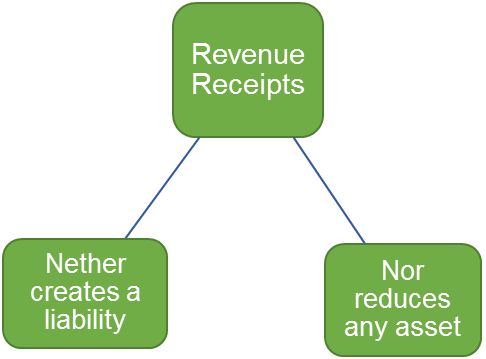
Revenue receipts are further classified into:
Tax Revenue:
- Tax revenue refers to receipts from all kinds of taxes such as income tax, corporate tax, excise duty etc.
- A tax is a compulsory legal payment imposed by the government on income and profit of persons and companies without reference to any benefit.
- Taxes are of two types: Direct taxes and Indirect taxes.
Direct Taxes:
- Liability to pay a tax (Impact of Tax), and (b) the burden of that tax (Incidence of tax), falls on the same person, it is termed as direct tax.
- A direct tax is paid directly by the same person on whom it has been levied. In other words, burden of a direct tax is borne by the person on whom it is imposed, which means the burden cannot be shifted to others.
- Alternatively, the person from whom the tax is collected is also the person who bears the ultimate burden of the tax. Income tax and corporate (profit) tax are most appropriate examples of direct tax.
Indirect Tax:
- Liability to pay a tax (Impact of tax) is on one person; and (b) the burden of that tax (Incidence of tax), falls on the other person, it is termed as indirect tax.
- In other words, indirect taxes are the taxes of whose burden can be shifted to others. In case of an indirect tax, person first pays the tax but he is able to transfer the burden of the tax to others.
- For instance, sales tax is an indirect tax. Government collects indirect tax from the seller of the commodity, who in turn realizes the tax amount from the buyer by including it in the price of the commodity. Other examples of indirect taxes are excise duty, custom duty, entertainment tax, service tax etc.
Non-Tax Revenue:
- Non-tax revenue refers to government revenue from all sources other than taxes.
- These are incomes, which the government gets by way of sale of goods and services rendered by different government departments.
Components of Non-Tax Revenue:
- Commercial Revenue (Profit and interest):
- It is the revenue received by the government by selling the goods and services produced by the government agencies.
- For example, profit of public sector undertakings like Railways, BHEL, and LIC etc.
- Government gives loan to State Government, union territories, private enterprises, public and earns interest receipts from these loans.
- It also includes interest and dividends on investments made by the government.
- Administrative Revenue: The revenue that arises on account of the administrative function of the government. This includes:
- Fee: Fee refers to a payment made to the government for the services that it renders to the citizens. Such services are generally in public interest and those, who receive such services, pay fees. For example, passport fees, court fees, school fees in government schools.
- License Fee: License fee is a payment to grant a permission by a government authority. For example, registration fee for an automobile.
- Fines and penalties for infringement of the law, i.e., they are imposed on lawbreakers.
- Special Assessment:
- Sometimes government undertakes developmental activities by which value of nearby property appreciates, which leads to increase in wealth. Special Assessment includes the payment made by owners of those properties whose value has appreciated. For example, if value of a property near a metro station has increased, then a part of developmental expenditure made by government is recovered from owners of such property. This is the value of special assessment.
- Forfeitures are in the form of penalties imposed by courts that a person needs to pay in the court of law for failing to comply with court orders.
- Escheat refers to the claim of the government on the property of a person who dies without having any legal heir or without leaving a will.
- External grants: Government receives financial help in the form of grants, gifts from foreign governments and international organisations (IMF, World Bank). Such grants and gifts are received during national crisis such as earthquakes, flood, war etc.
Capital Receipts:
- Government receipts that either creates liabilities (of payment of loan) or reduce assets (on disinvestment) are called capital receipts.
- Capital receipts include items, which are non-repetitive and non-routine in nature.
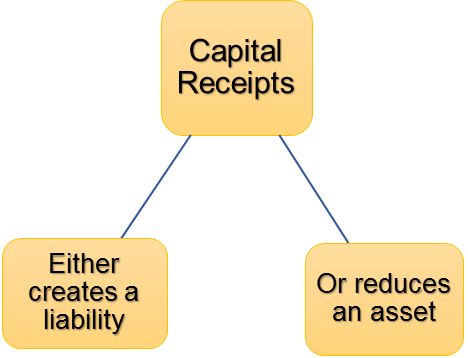
Components:
- Borrowing (Domestic and external): Borrowings are made to meet the financial requirement of the country. A government may borrow money:
- Domestically: General Public (By issuing government bonds in the open market).
- Externally: Rest of the world (foreign government and international institutions)
- Recovery of Loans and Advances:
- Loans offered to others are assets of the government. It includes recovery of loans granted by the central government to state and union territory governments.
- It is a capital receipt because it reduces financial assets of the government.
- For example, the government of India may give Rs.1000 crore as a loan to the state government of Delhi. Here the value of asset is Rs.1000 crore. When Delhi state government repays Rs.100 crore, the value of the assets of Government of India will reduce to Rs.900 crore. Since, recovery of loan reduces the value of assets, it is termed as a capital receipts.
- Disinvestment:
- A government raises funds from disinvestment also. Disinvestment means selling whole or a part of the shares (i.e., equity) of selected public sector enterprises held by government. As a result, government assets are reduced.
Difference between capital receipts and revenue receipts.

BUDGET EXPENDITURE
BUDGET EXPENDITURE
Revenue Expenditure:
- An expenditure that (a) Neither creates any assets (b) nor causes any reduction of liability.
- Examples of revenue expenditure are salaries of government employees, interest, payment on loans taken by the government, pensions etc.
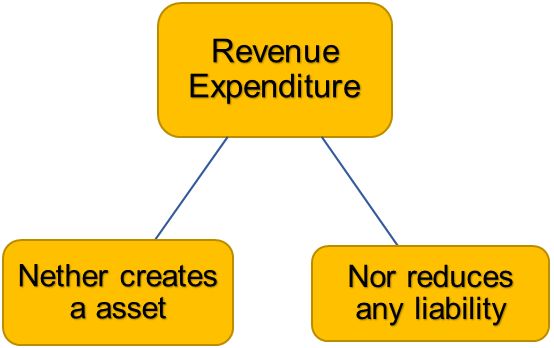
Capital Expenditure:
- An expenditure that either create assets for the government [equity or shares) of the domestic, or cause reduction in liabilities of the government.
- Examples include Loan to state and union territories, expenditure on building flyovers, road etc.
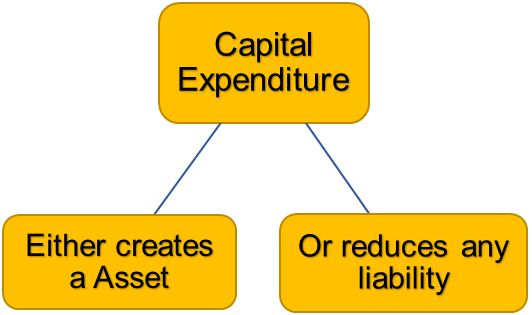
Difference between capital expenditure and revenue expenditure.

MEASUREMENT OF GOVERNMENT DEFICIT
Measures of Government Deficit.
Definition: Budgetary Deficit is defined as the excess of total estimated expenditure.
Budget deficit:
- Budgetary deficit refers to the excess of total budgetary expenditure (both revenue expenditure and capital expenditure) over total budgetary receipts (both revenue receipt and capital receipt).
- In other words, when sum of revenue receipts and capital receipts fall short of the sum of revenue expenditure and capital expenditure, budgetary deficit is said to occur.
Symbolically, Budgetary Deficit = Total Expenditure – Total Receipts
Types:
- (i) Revenue deficit
- (ii) Fiscal deficit
- (iii) Primary deficit
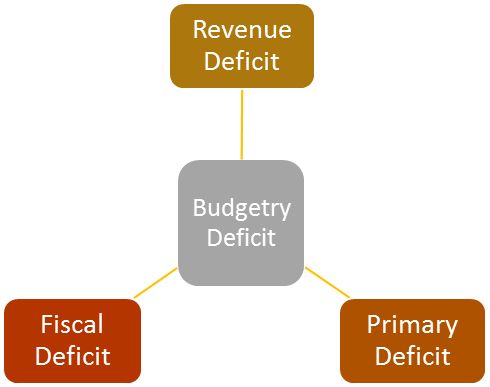
1. Revenue deficit:
Meaning: Revenue deficit refers to the excess of revenue expenditure of the government over its revenue receipts.
Symbolically, Revenue Deficit = Total Revenue Expenditure – Total Revenue Receipts.
Implications of revenue deficit:
- Revenue deficit indicates dis-savings on government account because the government has to make up uncovered gap.
- Revenue deficit implies that the government has to cover this uncovered gap by drawing upon capital receipts either through borrowing or through sale of its assets.
- Since government is using capital receipts to generally meet consumption expenditure of the government, it leads to an inflationary situation in the economy.
Measures to reduce revenue deficit are:
- Government should reduce its unproductive or unnecessary expenditure.
- Government should increase its receipts from various sources of tax and non-tax revenue.
2. Fiscal deficit:
Meaning: Fiscal deficit is defined as excess of total expenditure over total receipts (revenue and capital receipts) excluding borrowing.
In the form of an equation,
Fiscal Deficit = Total Expenditure – Totoal receipts excluding borrowings
- Fiscal deficit is a measure of total borrowings required by the government.
- Fiscal deficit indicates capacity of a country to borrow in relation to what it produces. In other words, it shows the extent of government dependence on borrowing to meet its budget expenditure.
- Another point to be noted here is that as the government borrowing increases, its liability in future to repay loan with interest also increases leading to a higher revenue deficit. Therefore, fiscal deficit should be as low as possible.
Implications of fiscal deficit:
- Causes Inflation: An important component of government borrowing includes borrowing from the Reserve Bank of India. This invariably implies deficit financing or meeting deficit requirements of the government by way of printing more currency. This is a dangerous practice, though very convenient for the government. It increases circulation of money and causes inflation.
- Increase in Foreign Dependence: Government also borrows from rest of the world. It increases our dependence on other countries. Foreign borrowing is often associated with economic and political interference by the lender countries. It increases our economic slavery.
- Financial Burden for Future Generation: Borrowing implies accumulation of financial burdens for the future generations. It is for future generations to repay loans as well as the mounting interest thereon.
- Deficits Multiply Borrowings: Payment of interest increases revenue expenditure of the government, causing an increase in its revenue deficit. Thus, a vicious circle is set wherein the government takes more loans to repay earlier loans, which is called Debt Trap.
Sources of Financing Fiscal Deficit
- Borrowings: From internal sources(public, commercial banks) and external sources(foreign governments, international organisations)
- Deficit Financing: Government may borrow from RBI against its securities to meet the fiscal deficit. RBI issues new currency for this purpose, this is known as deficit financing.
Comparison between Fiscal Deficit and Revenue Deficit.

3. Primary deficit:
Meaning: Primary deficit is defined as fiscal deficit minus interest payments.
Primary Deficit = Fiscal Deficit – Interest Payments
Implications of primary deficit:
- While fiscal deficit shows borrowing requirement of the government for financing the expenditure inclusive of interest payments, primary deficit reflects the borrowing requirements of the government for meeting expenditures other than interest payments on earlier loans.
Comparison between Primary Deficit and Fiscal Deficit.

FOREX
Foreign Exchange Rate
Definition: It refers to all the currencies of the rest of the world other than the domestic currency of the country. For example, in India, US dollar is a foreign currency.
The rate at which one currency is exchanged for another is called Foreign Exchange Rate.
- In other words, the foreign exchange rate is the price of one currency stated in terms of another currency. For example, if one U.S dollar exchanges for 60 Indian rupees, then the rate of exchange is $1 = Rs.60 or Rs1 = 1/60 or 0.0166 U.S. dollar.
- The exchange rate can fluctuate from year to year or even day to day. Like many other prices, exchange rate is determined by forces demand and supply.
Foreign Exchange Market
Definition: It is the market where the national currencies are converted, exchanged or traded for one another.
Currency Depreciation VS Currency Appreciation
Currency Depreciation
Meaning: It refers to decrease in the value of domestic currency in terms of foreign currency. It makes the domestic currency less valuable and more of it is required to buy the foreign currency.
Currency Appreciation
Meaning: It refers to increase in the value of domestic currency I terms of foreign currency. The domestic currency becomes more valuable and less of it is required to buy the foreign currency.
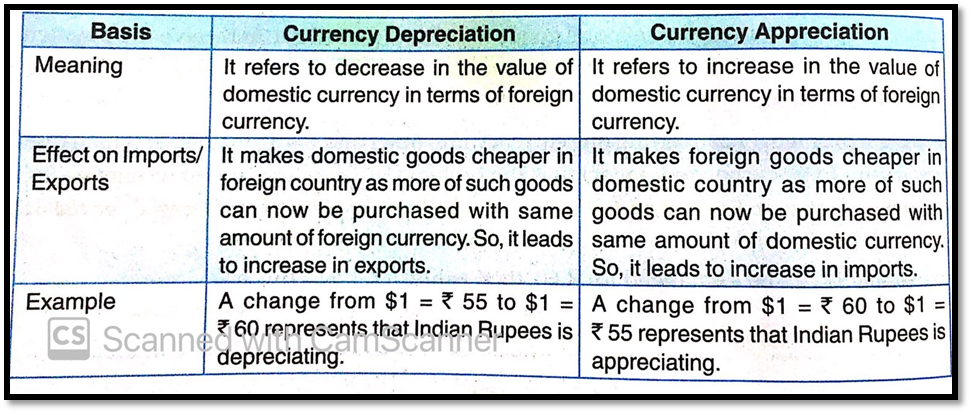
MARKET FORCES
Sources of Demand of Foreign Exchange:
The demand (or outflow) of foreign exchange comes from the people who need it to make payments in foreign currencies. The domestic residents for the following reasons demand it:
- Imports of Goods and Services: When India imports goods and services, foreign exchange is demanded to make the payment for imports of goods and services.
- Tourism: Foreign exchange is demanded to meet expenditure incurred in foreign tours.
- Unilateral Transfers Sent Abroad: Foreign exchange is required for making unilateral transfers like sending gifts to other countries.
- Purchase of Assets in Foreign Countries: It is demanded to make payment for purchase of assets, like land, shares, bonds, etc. in foreign countries.
- Repayment of loans to Foreigners: As and when we have to pay interest and repay the loans to foreign lenders, we require foreign exchange.
- Speculation: Demand for foreign exchange arises when people want to make gains from appreciation of currency.
Reasons for ‘Rise in Demand’ for Foreign Currency:
The demand for foreign currency rises in the following situations:
- When price of a foreign currency falls, imports from that foreign country become cheaper. Therefore, imports increase and hence the demand for foreign currency rises. For example, if price of 1 US dollar falls from Rs.60 to Rs.55, then imports from the USA will increase as American goods will become relatively cheaper. It will raise the demand for US dollar.
- When a foreign currency becomes cheaper in terms of the domestic currency, it promotes tourism to that country. As a result, demand for foreign currency rises.
- When price of a foreign currency falls, its demand rises as more people want to make gains from speculative activities.
Demand curve of foreign exchange:
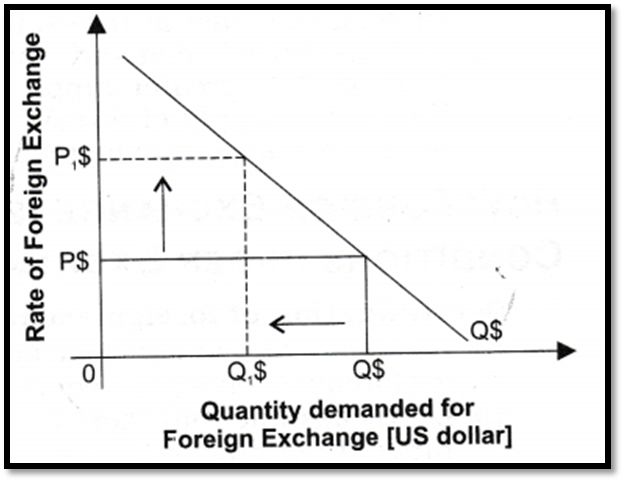
- Demand curve of foreign exchange slopes downwards due to inverse relationship between demand for foreign exchange and foreign exchange rate.
- In figure, demand for foreign exchange (US dollar) and rate of foreign exchange are shown on the horizontal axis and vertical axis respectively.
- The demand curve [US$] is downward sloping. It means that less foreign exchange is demanded as the exchange rate increases.
- This is due to the fact that rise in the price of foreign exchange increases the rupee cost of foreign goods, which make them more expensive. As a result, imports decline. Thus, the demand for foreign exchange also decreases.
Sources of supply of foreign exchange:
The supply (inflow) of foreign exchange comes from the people who receive it due to the following reasons.
- Exports of Goods and Services: Supply of foreign exchange comes through exports of goods and services.
- Tourism: The amount, which foreigners spend in the home country, increases the supply of foreign exchange.
- Remittances (unilateral transfers) from Abroad: Supply of foreign exchange increases in the form of gifts and other remittances from abroad.
- Loan from Rest of the world: It refers to borrowing from abroad. A loan from U.S. means flow of U.S. $ from U.S. to India, which will increase supply of Foreign exchange.
- Foreign Investment: The amount, which foreigners invest in our home country, increases the supply of foreign exchange.
- Speculation: Supply of foreign exchange comes from those who want to speculate on the value of foreign exchange.
Reasons of ‘Rise in Supply’ of foreign currency:
The supply of foreign currency rises in the following situations:
- When price of a foreign currency rises, domestic goods become relatively cheaper. It induces the foreign country to increase their imports from the domestic country. As a result, supply of foreign currency rises. For example, if price of 1 US dollar rises from Rs.60 to Rs.65, then exports to USA will increase as Indian goods will become relatively cheaper. It will raise the supply of US dollars.
- When price of a foreign currency rises, foreign direct investment (FDI) from rest of the world increases, which will increase the supply for foreign exchange.
- When price of a foreign currency rises, supply of foreign currency also rises as people want to make gains from speculative activities.
Supply curve of foreign exchange:
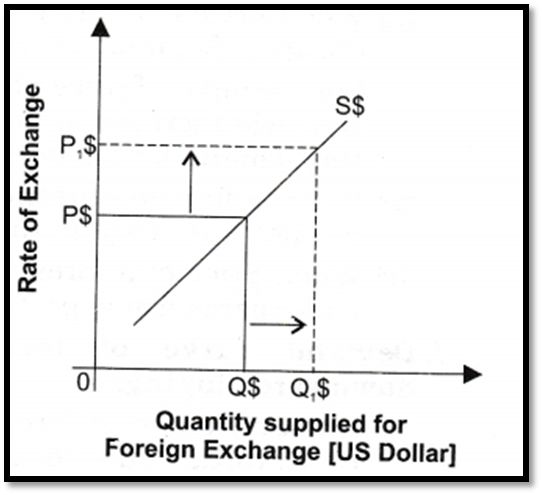
- Supply curve of foreign exchange slopes upwards due to positive relationship between supply for foreign exchange and foreign exchange rate, which means that supply of foreign exchange increases as the exchange rate increases.
- This makes home country’s goods cheaper to foreigners since rupee is depreciating. The demand for our exports should therefore increase as the exchange rate increases.
- The increased demand for our exports will translate into greater supply of foreign exchange. Thus, the supply of foreign exchange increases as the exchange rate increases.
TYPES OF FOREIGN EXCHANGE RATE
Types of Foreign Exchange Rates:
Fixed exchange rate system (Pegged exchange rate system):
Meaning: A system in which exchange rate of a currency is fixed by the government.
- When domestic currency is tied to the value of foreign currency, it is known as
pegging. - To maintain stability in fixed exchange rate system, government buy foreign currency when exchange rate appreciates and sell foreign currency when exchange rate depreciate. This process is called Pegging operation, i.e., all efforts made by the central bank to keep the rate of exchange stable.
Note:
- Fixed exchange rate is not determined by the forces of demand and supply in the market. Such a rate of exchange has been associated with Gold Standard System during 1880-1914.
- According to this system, value of every currency is determined in terms of gold. Accordingly, ratio between gold values of the two countries were fixed as exchange rate between those currencies.
- For example, Value of one dollar = 100 gms of gold.
Value of a rupee = 5 gms of gold
Then, 1 dollar = 100/5 = Rs.20
Merits of fixed exchange rate system:
- Stability: It ensures stability, in the international money market/exchange market. Day to day fluctuations are avoided. It helps formulation of long term economic policies, particularly relating to exports and imports.
- Encourages international trade: Fixed exchange rate system implies low risk and low uncertainty of future payments. It encourages international trade.
- Co-ordination of macro policies: Fixed exchange rate helps co-ordination of macro policies across different countries of the world. Long-term economic policies can be drawn in the area of international trade and bilateral trade agreements.
Demerits of fixed exchange rate system:
- Huge international reserves: Fixed exchange rate system is often supported with huge international reserves of gold. This is because different currencies are directly or indirectly convertible into gold.
- Restricted movement of capital: Fixed exchange rate restricts the movement of capital across different parts of the world. Accordingly, international growth process suffers.
- Discourages venture capital: Venture capital in the international money market refers to investments in the purchase of foreign exchange in the international money market with a view to earn profits. Fixed exchange rate system discourages such investments. Fixed exchange rate discourages venture capital in the international money market.
Devaluation of currency: Devaluation refers to decrease in the value of domestic
currency in terms of foreign currency by the government. It is a part of fixed
exchange rate.
Revaluation of currency: Revaluation refers to increase in the value of domestic
currency by the central government. It is a part of fixed exchange rate.
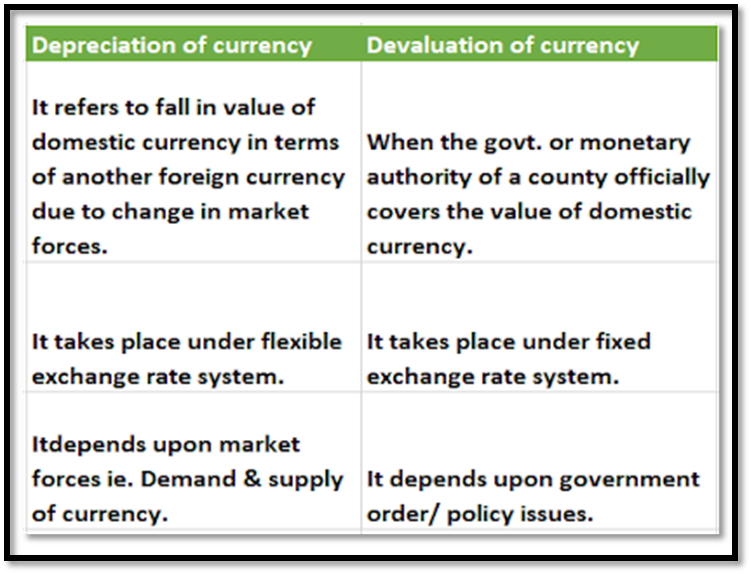
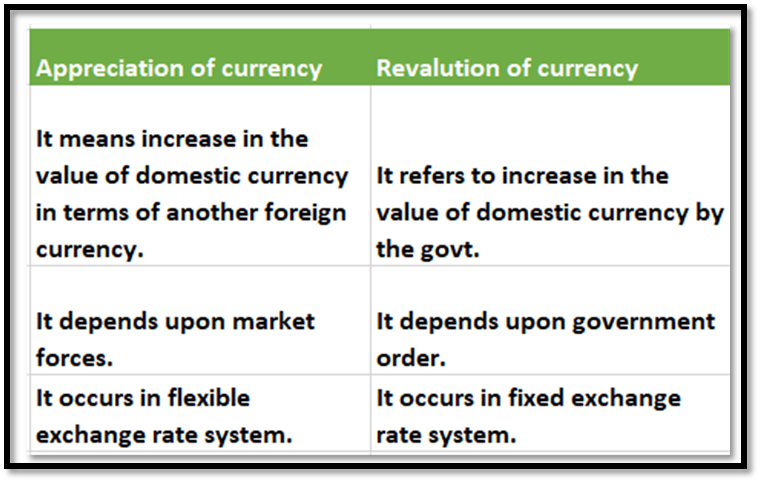
Flexible exchange rate (floating exchange rate system):
Meaning: The system of exchange rate in which value of a currency is allowed to float freely as determined by the demand and supply foreign exchange.
- Under this system, the central banks, without intervention, allow the exchange rate to adjust to equate the supply and demand for foreign currency.
- The foreign exchange market is busy at all times by changes in the exchange rates.
Merits of flexible exchange rate system:
- No need for international reserves: Flexible exchange rate system is not to be supported with international reserves.
- International capital movements: Flexible exchange rate system enhances movement of capital across different countries of the world. This is due to the fact that member countries are no longer required to keep huge international reserves.
- Venture capital: Flexible exchange rate promotes venture capital in foreign exchange market. Trading in international currencies itself becomes an important economic activity.
Demerits of flexible exchange rate system:
- Instability: It causes instability in the international money market. Exchange rate tends to fluctuate like price of goods in the commodity market.
- International trade: Instability in foreign exchange market causes instability in the area of international trade. It becomes difficult to draw long period policies of exports and imports.
- Macro policies: While fixed exchange rate helps coordination of macro policies, flexible exchange rate makes it a difficult proposition. Day to day fluctuations in exchange rate makes bilateral trade agreements a difficult exercise.
Difference between Fixed exchange rate and Flexible exchange rate system:
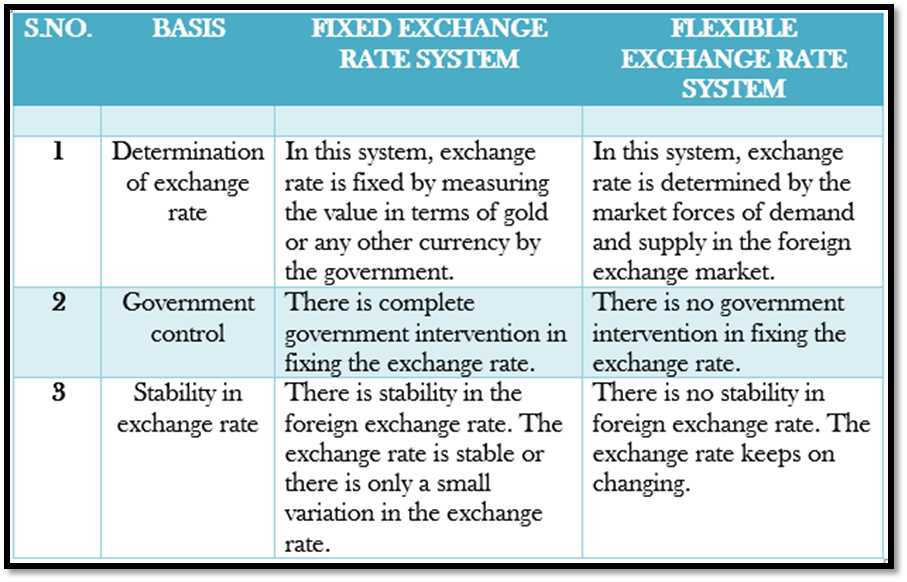
Managed floating rate system:
- Managed floating exchange rate is a mixture of a flexible exchange rate (the float part) and a fixed exchange rate (the Managed part).
- In other words, it refers to a system in which foreign exchange is determined by free market forces (demand and supply forces), which can be influenced by the intervention of the central bank in foreign exchange market.
- Under this system, also called Dirty floating, central banks intervene to buy or sell foreign currencies in an attempt to stabilize exchange rate movements in case of extreme appreciation or depreciation.
CHANGES IN FOREX
Determination of Foreign Exchange Rate:
- Exchange rate in a free exchange market is determined at a point, where demand for foreign exchange is equal to the supply of foreign exchange.
- Let us assume that there are two countries – India and U.S.A – and the exchange rate of their currencies i.e., rupee and dollar is to be determined. Presently, there is floating or flexible exchange regime in both India and U.S.A. Therefore, the value of currency of each country in terms of the other currency depends upon the demand for and supply of their currencies.
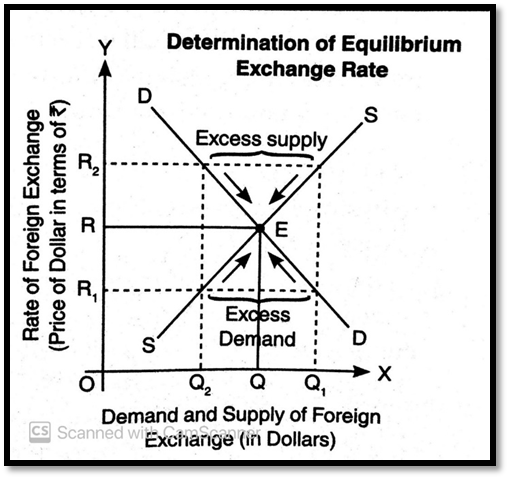
- In the above diagram, the price on the vertical axis is stated in terms of domestic currency (that is, how many rupees for one US dollar). The horizontal axis measures the quantity demanded or supplied.
- In the above diagram, the demand curve [DD] is downward sloping. This means that less foreign exchange is demanded as the exchange rate increases. This is due to the fact that the rise in price of foreign exchange increases the rupee cost of foreign goods, which make them more expensive. As a result, imports decline. Therefore, the demand for foreign exchange also decreases.
- The supply curve [SS] is upward sloping which means that supply of foreign exchange increases as the exchange rate increases.
- This makes home country’s goods become cheaper to foreigners since rupee is depreciating in value. The demand for our exports should therefore increase as the exchange rate increases.
- The increased demand for our exports translates into greater supply of foreign exchange. Therefore, the supply of foreign exchange increases as the exchange rate increases.
Disequilibrium conditions under Equilibrium exchange rate:
Change in demand:
- Increase in demand for dollar: An increase in the demand for US dollar in India will cause the demand curve to shift to D1$ and the exchange rate rises to P1$. Note that increase in the exchange rate means that more rupees are required to buy one US dollar. When this occurs, Indian rupee is said to be depreciating.
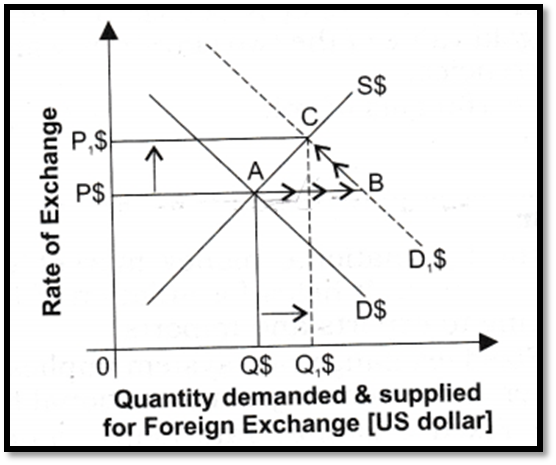
- Decrease in demand for dollar: A decrease in the demand for US dollar in India will cause the demand curve to shift to D1$ and the exchange rate falls to P1$. Note that decrease in the exchange rate means that less rupees are required to buy one US dollar. When this occurs, Indian rupee is said to be appreciating.
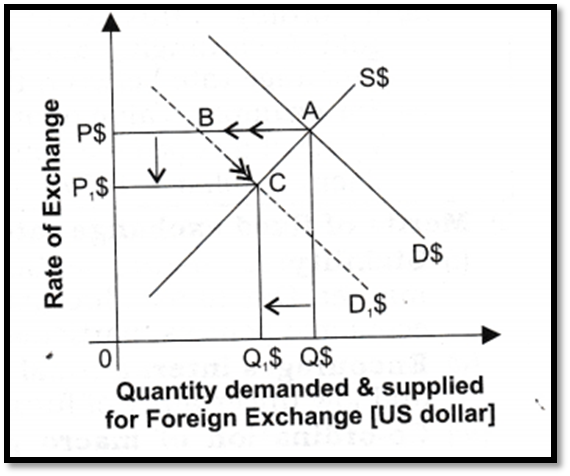
Change in Supply
- Increase in supply for dollar: An increase in the supply of US dollar causes the supply curve to shift to S1$ and exchange rate falls to P1$. In this case, rupee cost of US dollar is decreasing and the Indian rupee is said to be appreciating.
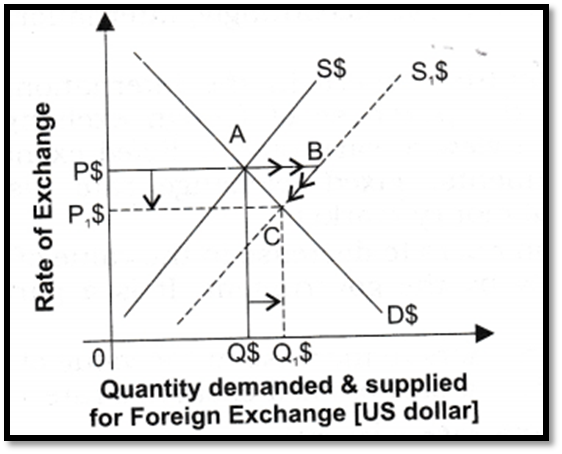
- Decrease in supply of dollar: A decrease in the supply of US dollar causes the supply curve to shift to S1$ and exchange rate rises to P1$. In this case, rupee cost of US dollar is increasing and the Indian rupee is said to be depreciating.
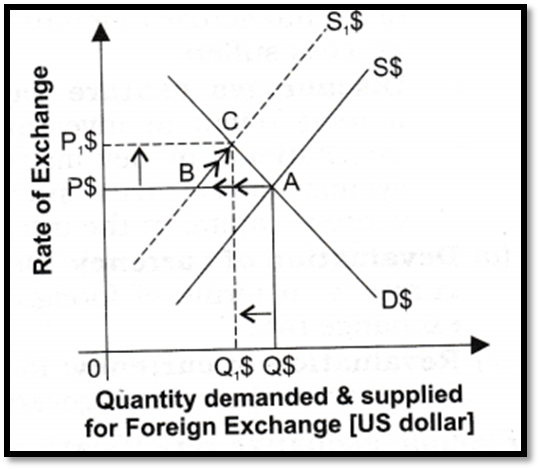
FUNCTIONS OF FOREIGN EXCHANGE MARKET
Functions of a Foreign Exchange Market:
- Transfer Function: Transfer function refers to transferring of purchasing power
among countries. - Credit Function: It implies provision of credit in terms of foreign exchange for the export and import of goods and services across different countries of the world.
- Hedging Function: Hedging function pertains to protecting against foreign exchange risks. Hedging is an activity, which is designed to minimize the risk of loss.
KINDS OF FOREIGN EXCHANGE MARKETS
Kinds of Foreign Exchange Market
1. Spot market:
Meaning: It refers to the market in which the receipts and payments are made immediately.
- If the operation is of daily nature, it is called spot market or current market
- The exchange rate that prevails in the spots market for foreign exchange is called spot rate.
- In other words, spot rate of exchange refers to the rate at which foreign currency is available on the spot.
2. Forward market:
Meaning: It refers to the market in which sale and purchase of foreign currency is settled on a specified future date at a rate agreed upon today.
- A market for foreign exchange for future delivery is known as forward market.
- Exchange rate that prevails in a forward contract for purchase or sale of foreign exchange is called forward rate.
- Thus, forward rate is the rate at which a future contract for foreign currency is bought and sold.
BOP
Balance of payments
Definition: An accounting statement provides a systematic record of all economic transactions, between its residents and rest of the world, during a given period of time.
- Economic transactions are the transactions, which cause transfer of title or ownership. In the context of foreign transactions, value is transferred by the residents of one country to the residents of other country. Example: when exports of goods or services are made by country A to country B, value (= export receipts) is transferred by country B to country A. Between the countries, value is transferred in terms of foreign exchange (i.e. payments are received and made in terms of foreign exchange).
- Residents here include individual, firms and government agencies. However, residents do not include diplomatic staff, foreign military personnel, tourist, migratory workers and branches of foreign companies
Economic transactions are broadly categorised as:
- Visible items: This includes all types of physical goods that are exported and imported.
- Invisible items: It refers to all types of services like shipping, banking, insurance etc, which are given and received. These cannot be seen, felt, touched or measured.
- Unilateral transfers: These include gifts, personal remittances, and other one-way transactions. They are also known as unrequited transfers.
- Capital transfers: These relate to capital receipts and capital payments.
TYPES OF BOP
Balance Of Payments and Its Types
Balance: It means difference between the sum of credits and sum of debits. The BOP account records three balances:
(a) Balance of trade
(b) Balance on current account
(c) Balance on capital account
- Balance of trade: The term “balance of trade” denotes the difference between the exports and imports of goods in a country. Balance of trade refers to the visible items only. It is the difference between the value of merchandise (goods) exports and imports.
Balance of Trade = Export of visible goods – Import of visible goods.
BOT can be surplus or deficit:
- Surplus BOT: If a country exports more than what it imports, then the BOT is said to be in surplus that is favourable for the country.
- Deficit BOT: If import of goods exceeds the export of goods, then the country is said to have a deficit BOT that is unfavourable for the country.
- Balance on current account: It is the difference between sum of credits and sum of debits on current account.
Balance on Current Account = Sum of credits on current account – Sum of debits on current account
- Balance on capital account: It is the difference between sum of credits and sum of debits on capital account.
Balance on capital account = Sum of credits on capital account – Sum of debits on capital account
STRUCTURE OF BOP
Structure of Balance of Payments
- Transactions are recorded in the balance of payments accounts in double-entry book keeping system.
- Each international transaction undertaken by country will results in a credit entry and debit entry of equal size.
- As international transactions are recorded in double entry accounting, the BOP accounting must always balance i.e., total amount of debits must be equal to total amount of credits.
- The balancing item Errors and omissions must be added to “balance” the BOP accounts.
- By convention, debit items and credit items are entered with a minus sign and plus sign respectively.
Transactions in BOP are classified into the following five major categories:
- Goods and services account
- Unilateral transfer account
- Long-term capital account
- Short-term private capital account
- Short-term official capital account
In economics sense, BOP need not be always equal. BOP can be:
- Balanced BOP: BOP is balances when receipts of foreign exchange are equal to payments of foreign exchange.
- Surplus BOP: BOP is in surplus when receipts of foreign exchange are more than payments of foreign exchange.
- Deficit BOP: BOP is in deficit when receipts of foreign exchange are less than payments of foreign exchange.
Components of BOP
Current Account:
Meaning: Current account records imports and exports of goods and services and unilateral transfers during a given period of time.
The main components of Current Account are:
- Export and Import of Goods (Merchandise Transactions or Visible Trade):
A major part of transactions in foreign trade is in the form of export and import of goods (visible items). Payment for import of goods is written on the negative side (debit items) and receipt from exports is shown on the positive side (credit items). Balance of these visible exports and imports is known as balance of trade (or trade balance). - Export and Import of Services (Invisible Trade): It includes a large variety of non-factor services (known as invisible items) sold and purchased by the residents of a country, to and from the rest of the world. Payments are either received or made to the other countries for use of these services. Services are generally of three kinds: (a) Shipping, (b) Banking, and (c) Insurance. Payments for these services are recorded on the negative side and receipts on the positive side.
- Unilateral or Unrequited Transfers to and from abroad (One sided Transactions): Unilateral transfers include gifts, donations, personal remittances and other ‘oneway’ transactions. These refer to those receipts and payments, which take place without any service in return. Receipt of unilateral transfers from rest of the world is shown on the credit side and unilateral transfers to rest of the world on the debit side.
- Income receipts and payments to and from abroad: It includes investment income in the form of interest, rent and profits.
Difference between BOT and Current account:

Capital Account
Meaning: Capital account is that account which records all such transactions, between residents of a country and rest of the world, which cause a change in the asset or liability status of the residents of a country or its government.
The main components of capital account are:
(i) Loans:
- All transactions related to borrowing from abroad by private sector, government etc. Receipts of such loans and repayments of loans by foreigners are recorded on the positive side.
- All transactions of lending to abroad by private sector and government. Lending abroad and repayment of loans to abroad is recorded as negative or debit item.
(ii) Foreign Investment (Investments to and from abroad):
- Investments by rest of the world in shares of Indian companies, real estate in India, etc. Such investments from abroad are recorded on the positive (credit) side as they bring in foreign exchange.
- Investments by Indian residents in shares of foreign companies, real estate abroad, etc. Such investments to abroad are recorded on the negative (debit) side as they lead to outflow of foreign exchange.
- ‘Investments to and from abroad’ includes two types of investments:
- Foreign Direct Investment (FDI)
It refers to purchase of an asset in rest of the world, such that it gives direct control to the purchaser over the asset.
For example, (i) acquisition of a firm in the domestic country by a foreign country’s firm (ii) transfer of funds from the parent company abroad to the subsidiary company in the domestic country. - Portfolio Investment
Portfolio Investment refers to the purchase of financial asset by the foreigners that does not give the purchaser control over the asset. A foreign Institutional Investment (FII) is also a part of portfolio investment.
For instance, purchase of shares of a foreign company, purchase of foreign government’s bonds, etc. are treated as portfolio investments.
- Foreign Direct Investment (FDI)
(iii) Change in Foreign Exchange Reserves
- The foreign exchange reserves are the financial assets of the government held in
central bank. A change in reserves serves as the financing item in India’s BOP. - Therefore, any withdrawal from the reserves is recorded on the positive (credit) side and any addition to these reserves is recorded on the negative (debit) side.
- It must be noted that ‘change in reserves’ is recorded in the BOP account and not ‘reserves’.
Difference between Capital account and Current account:

BALANCE OF BOP
Deficit in BOP
- The balance of payments of a country is a systematic record of all economic transactions between the residents of foreign countries during a given period of time.
- The transaction in the balance of payment account can be categorized as autonomous transactions and accommodating transactions.
- Autonomous transactions are transactions done for some economic consideration such as profit.
- When the total inflows on account of autonomous transactions are less than total outflows on account of such transactions, there is a deficit in the balance of payments account.
- Suppose, the autonomous inflow of foreign exchange during the year is $500, while the total outflow is $600. It means that there is a deficit of $100.
Disequilibrium in Balance of Payments:
There are a number of factors that cause disequilibrium in the balance of payments, showing either a surplus or deficit. These causes are:
- Economic Factors
(i) Large scale development expenditure that may cause large imports.
(ii) Cyclical fluctuations in general business activity such as recession or depression.
(iii) High domestic prices may result in imports. - Political Factors: Political factors instability may cause large capital outflows and hamper the inflows of foreign capital.
- Social Factors: Changes in tastes, preference and fashions of the people bring disequilibrium in BOP by inflowing imports and exports.
In economics sense, BOP need not be always equal. BOP can be:
- Balanced BOP: BOP is balances when receipts of foreign exchange are equal to payments of foreign exchange.
- Surplus BOP: BOP is in surplus when receipts of foreign exchange are more than payments of foreign exchange.
- Deficit BOP: BOP is in deficit when receipts of foreign exchange are less than payments of foreign exchange.
BOT
Balance of trade: The term “balance of trade” denotes the difference between the exports and imports of goods in a country. Balance of trade refers to the visible items only. It is the difference between the value of merchandise (goods) exports and imports.
BOT is also known as ‘Balance of Visible Trade’ or ‘Trade Balance’.
Balance of Trade = Export of visible goods – Import of visible goods.
BOT can be surplus or deficit:
- Surplus BOT: If a country exports more than what it imports, then the BOT is said to be in surplus that is favourable for the country.
- Deficit BOT: If import of goods exceeds the export of goods, then the country is said to have a deficit BOT that is unfavourable for the country.
Difference between BOT & BOP.
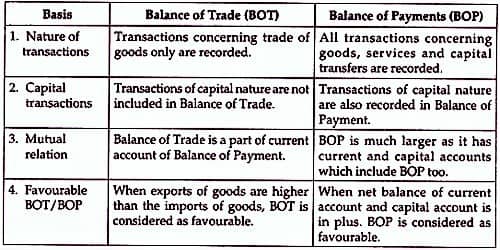
AUTONOMOUS & ACCOMODATING ITEMS
Autonomous Items
- Autonomous items refer to those international economic transactions in the
current account and capital account, which take place due to some economic motive such as profit maximisation. - These transactions are independent of the state of BOP account.
- These items are also known as ‘above the line items’.
- For example, if a foreign company is making investments in India with the aim of earning profit, then such a transaction is independent of the country’s BOP situation.
Accommodating items
- Accommodating items refer to the transactions that are undertaken to cover deficit or surplus in autonomous transactions, i.e., such transactions are determined by net consequences of autonomous transactions.
- These items are also known as ‘below the line items’.
- For example, if there is a current account deficit in BOP, then this deficit is settled by capital inflow from abroad. The sources used to meet a deficit in BOP, are: (i) Foreign exchange reserves; (ii) Borrowings from IMF or foreign monetary authorities.

 Mayank classes
Mayank classes
 PathSet Publications
PathSet Publications
